SEE THROUGH THE NOISE

© MACIEK NABRDALIK
ALEXANDRA BOULAT 4
ALI ARKADY 6 STRAPPADO
ANUSH BABAJANYAN 8 TROUBLED HOME
ASHLEY GILBERTSON 10 WHISKEY TANGO FOXTROT
CHRISTOPHER MORRIS 12 ON CHECHNYA
DANIEL SCHWARTZ 14 THE GREAT WALL OF CHINA (1987-1988)
DANNY WILCOX FRAZIER 16 LOST NATION
ED KASHI 18 AGING IN AMERICA
ERIC BOUVET 20 UKRAINE: WAR DIARY
ESPEN RASMUSSEN 22 EARTHQUAKE IN KASHMIR
FRANCO PAGETTI 24 VEILED ALEPPO
GARY KNIGHT 26 INVASION: THE BATTLE FOR DYALA BRIDGE, IRAQ
ILVY NJIOKIKTJIEN 28 BORN FREE
JOHN STANMEYER 30 SIGNAL
JOACHIM LADEFOGED 32 MITROVICA, KOSOVO
JOCELYN BAIN HOGG 34 THE FIRM
LINDA BOURNANE ENGELBERTH 36 DIARY FROM ALGERIA
MACIEK NABRDALIK 38 LESBOS
MAGGIE STEBER 40 ON HAITI
NICHOLE SOBECKI 42 A CLIMATE FOR CONFLICT
PAUL LOWE 44 A FAMINE IN SOMALIA
PHILIP BLENKINSOP 46 HMONG IN LAOS
RON HAVIV 48 WAR CRIMES IN BOSNIA AND HERZEGOVINA
SARA TERRY 50 AFTERMATH
SEAMUS MURPHY 52 THE REPUBLIC
STEFANO DE LUIGI 54 KENYA DROUGHT
TOMAS VAN HOUTRYVE 56 BLUE SKIES
ZIYAH GAFIC 58 QUEST FOR IDENTITY
SEE THROUGH THE NOISE
The dawn of the digital era enabled the creation of VII on the 8th of September 2001. Three days later, Al Qaeda attacked the United States. In the following months, while the burning dust of the Twin Towers still choked New York, all seven founding members documented the violence that followed. In the ensuing years, as the narrative of the new century was being written, they photographed the invasion and occupation of Iraq, the wars in the Middle East, and the chaos that smothered an unjust world. The name VII became synonymous with courageous and impactful photojournalism.
VII went small and photographer-owned. The photographers believed in the power and energy of intimate collective effort at a time when corporations were acquiring smaller photo agencies and consolidating what had been a rich and diverse ecosystem into giant conglomerates. VII was created to give its members independence and enhance their ability to work on stories that mattered in partnership with the world’s leading press. It created new opportunities the photographers could not imagine. But the digital revolution that enabled the growth of VII also precipitated a catastrophic loss in revenue for its clients in the press.
Photojournalism means taking risks; it requires initiative, resourcefulness, empathy, and courage. It also involves trust, imagination, collaboration, and partnership. Publications and the photo agencies that served them were once
essential partners in the life of a photojournalist. But trying to sell the news to a public that expects it for free means the press has fewer resources to deploy independent photographers and commission original work. Consequently, the media and photo agencies now have less impact and influence on the production of visual journalism. So, what next?
Anticipating the shrinking space the media would occupy in the lives of photographers, The VII Foundation was created to innovate and lead in the non-profit arena, unlimited by the constraints of the editorial marketplace. One of its objectives is to train and support photographers as they continue scrutinizing a world in turmoil and hold those who crave power to account. Ours is a world where leaders regard facts as optional, human rights as an inconvenience, and where it is increasingly difficult to differentiate between artifice and truth. Even the word truth is hard to explain — and is best defined by being the opposite of something — falsehood.
This is the first collective exhibition by VII in Arles, and it marks the acquisition of VII by The VII Foundation earlier this year. The photographs on these walls are among the most significant images of the events and issues they portray. They are an enduring testament to the importance to our fragile societies of a bold form of journalism that is free of artifice and falsehood, and that is an essential pillar of The VII Foundation.
Production & Curation: Ziyah Gafic / Gary Knight / Yonola Viguerie
Editor: Amber Maitland
Co-producer: Marianne Tollié
Graphic Design: Enes Huseinčehajić
Printing Labs: BlackBOX Sarajevo / ateliershl, Arles
ALEXANDRA BOULAT

ALEXANDRA BOULAT 1962 – 2007




Alexandra Boulat, with her friends John Stanmeyer and Gary Knight, was an early driving force behind the creation of VII. Born into a distinguished photography family, she was an artist before she chose to work as a photojournalist and war photographer. She was one of the most influential photographers to document the Balkan wars, paving the way for many female photographers who followed. She spent much of her professional life focusing on the impact of war on women; she was the architect of one of the most deliberate, focused, and militant bodies of work on the victims of conflict and injustice of our time. She once said, “You can show a war without showing a gun”, a maxim illustrated powerfully by her poignant and devastating photograph in this exhibition. At the time of her premature death in 2007, she was elected a Chevalier de l’ordre des Arts et des Lettres.



COURTESY OF ASSOCIATION PIERRE & ALEXANDRA BOULAT ©
JEROME DELAY
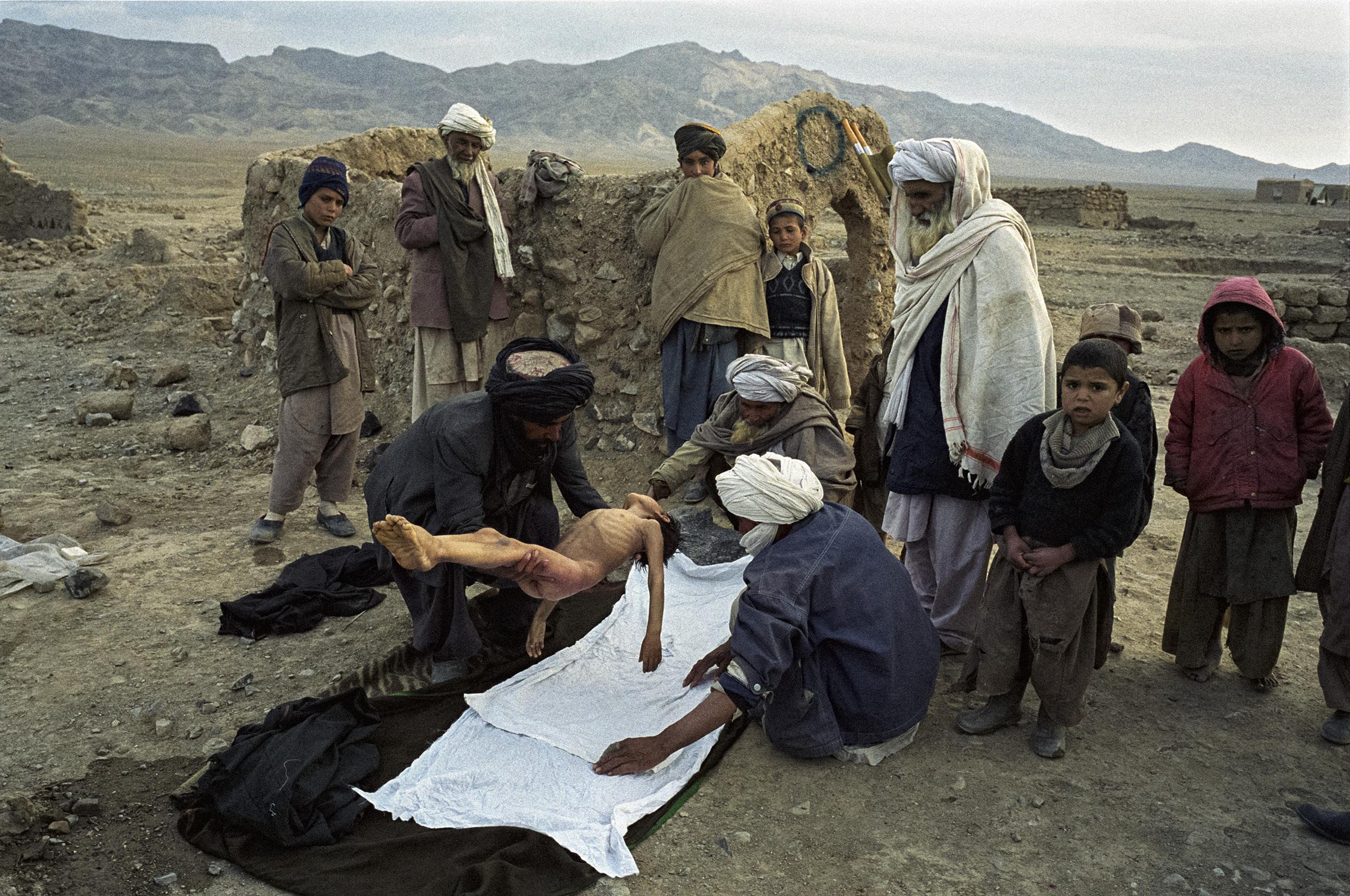 Preparations for the funeral of an 8-year-old child who died of cold in Herat Marsak refugee camp. His two uncles prepare the body before bringing him to the camp cemetery under the eyes of a few of his family members. 30,000 internally displaced people live in miserable conditions in a camp a few kilometers away from Herat, Western Afghanistan. Because of the draught and the war raging on several fronts in Afghanistan, one million people face a humanitarian disaster all over the country. Near Herat, Western Afghanistan, February 15, 2001.
Preparations for the funeral of an 8-year-old child who died of cold in Herat Marsak refugee camp. His two uncles prepare the body before bringing him to the camp cemetery under the eyes of a few of his family members. 30,000 internally displaced people live in miserable conditions in a camp a few kilometers away from Herat, Western Afghanistan. Because of the draught and the war raging on several fronts in Afghanistan, one million people face a humanitarian disaster all over the country. Near Herat, Western Afghanistan, February 15, 2001.
ALI ARKADY STRAPPADO
Are the good guys any better than the bad guys?

my body to carry on filming. had to concentrate on being journalist.” He had been filled with optimism the first time that he “embedded” with the Emergency Response Division, unit under Iraq’s interior ministry, as it rooted out insurgents in the city of Fallujah last year. One of its commanders was Sunni, the other Shi’ite, and they were close friends. Arkady regarded this as story of hope, an example of how the country might overcome the sectarian violence that has bathed it in blood since the American-led intervention against Saddam in 2003. “They were heroes to
Ali Arkady (b. 1982, Iraq) is an artist, photographer, and filmmaker. In 2017, Arkady had to flee Iraq with his family when his life was threatened after he photographed Iraqi armed forces committing war crimes. He sought refuge in Europe, where he was granted asylum and subsequently built a new life. His photographs of war crimes in Iraq were published worldwide by international media and put pressure on the Iraqi government to acknowledge the crimes committed by their soldiers. For this work, Arkady won the prestigious Bayeux Calvados-Normandy Award for War Correspondents in 2017 and the Free Press Unlimited Most Resilient Journalist Award in 2019 for his exceptional courage and persistence. Now an educator and mentor, he counsels young journalists from troubled parts of the world on staying safe while reporting stories that threaten to upend their lives as his was.

kicking his legs as he suffocated.”



that occasion Arkady watched in silent horror, too shocked to take pictures.


‘heroes’ were doing things that would never have believed possible,” he says.
decided to go
against
for
and the entreaties of his
he returned to

wanted him to be
in
front.
The nightmare intensified. By late November, soldiers had recaptured the village of Qabr Al-Abd from Isis and several young men were arrested. Arkady took pictures of them, only to hear later that they too had been executed.







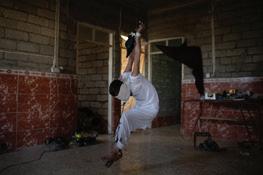



“Far from ‘heroes’, they were sadistic torturers, rapists and killers making a mockery of Geneva conventions”




Civilians began pouring out of former Isis territory, including dozens of men. Among them was Mahdi Mahmoud, farmer, and his 16-year-old son, who was suspected of belonging to Isis. When Arkady walked into the interrogation room he saw Mahmoud hanging from the ceiling with his arms extended behind him, his back weighed down with pallet of water bottles as the soldiers beat him. Arkady took photographs and recorded video. “Nobody tried to stop me.” Mahmoud’s son was being questioned next door — he was eventually killed. The father survived. “I thought to myself, ‘What is this you are doing? Filming torture? And why do they let me film it?’ He reached the conclusion that, for them, “it was just normal” and that they had “lost all idea of right and wrong”. In any case, they did not expect Arkady to publish his footage. “So said to myself, ‘You must carry on.’ Foreign correspondents were covering fighting in the area but would follow Iraqi forces only by day. By night, Arkady was left alone with them to chronicle crimes, accompanying them on raids of civilian homes. The soldiers were constantly looking for money to steal and pretty women to

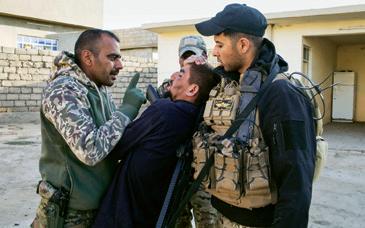









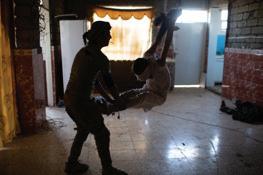
“It was clear that my life would be in danger as soon as I published evidence of these war crimes”

Over many months, the photographer Ali Arkady bore witness to the brutality of our allies in Iraq. Now, as victory is declared over Isis in Mosul, he risks his life to reveal the truth Matthew Campbell reports INHUMAN TREATMENT shepherd whose son had fought for Isis is tortured by the Iraqi military during operations in Mosul, 2016 The Sunday Times Magazine 15 The Sunday Times Magazine One man hangs from the ceiling, arms stretched at an impossible angle behind him, moaning in agony. Another kneels in the sand, then leaps up, trying to flee, begging for his life. Two men run after him, shooting. He falls, his body twitching at each bullet. The video looks like the handiwork of Isis, which relishes posting horrors online. What makes these atrocities even more shocking that they were carried out not by the bearded extremists of the caliphate but by the Iraqi government’s Americantrained security forces. Ali Arkady, prizewinning Kurdish photographer, has risked his life by publishing what amounts to evidence of war crimes by our allies in the fight against terror. “It is important for the world to see what they are doing. want to stop them doing more of it,” says Arkady in an interview with The Sunday Times after fleeing Iraq with his wife and daughter. He in Europe but did not want us to say where: wanted man in his homeland, he has received death threats since smuggling his photos out of the country. A compact, diminutive figure with melancholic eyes and gentle smile, Arkady, 36, has lived his whole life in the shadow of war. One of his earliest memories is of dog eating body on street in Khanaqin, his home town in northeastern Iraq, during the dictator Saddam Hussein’s savage campaign against Kurds. But Iraq’s latest, bloody convulsions and the scenes Arkady chronicled as photographer have left greater mark on his soul. On two occasions, he was compelled to participate in beatings of prisoners, crossing the line from observer to unwilling accomplice — “a very, very bad thing”, he admits, that has left him consumed by guilt over how his sense of morality was drowned by the will to survive. He watched as prisoners he believes to have been innocent were cut with knives, suffocated with plastic bags or hanged by their arms from the ceiling as interrogators screamed at them to confess their allegiance to Isis. “I will never get the images out of my mind,” says Arkady, speaking at the home of friends. “Each day, the camera felt heavier and heavier in my hand. By the end, could barely hold it. had to take my heart out of
me,” Arkady says. “I thought that maybe these two would heal all the divisions between Sunni and Shia.” He set up a Facebook page called — with touch of irony — “Happy Baghdad” and posted short video on about the two officers, entitled “liberators not destroyers”. Captain Omar Nazar, the Sunni, and Sergeant Haider Sada, the Shi’ite, were thrilled by this unusually positive attention. In October last year, they invited Arkady to join them on the front line in the northern city of Mosul. But as the trusted photographer gained more access to the soldiers and their daily routine, darker narrative emerged: far from “heroes”, the officers he had befriended were sadistic torturers, rapists and killers who made mockery of the Geneva conventions. As government forces tightened the noose around the Islamic State’s last Iraqi enclave, another of the commanders, Captain Thamer Al-Douri, confided in him that he had personally executed many prisoners. “He told me that at first he would shoot them in the arms and legs,” Arkady says. “But after his brother, who was also soldier, was killed in fighting, he started to kill.” He invited Arkady to watch him dispatching prisoners — the photographer declined. Then, one day, Al-Douri summoned Arkady to witness him questioning young suspected Isis member called Ali. He placed plastic bag over his head and beat him repeatedly, commanding him to proclaim the Isis oath of allegiance. Arkady was handed Al-Douri’s mobile phone to provide light from the torch app. “The young man kept saying he didn’t know the oath of allegiance, then the plastic bag went back over his head. He was
On
“My
He
home
break. Then,
all his instincts
father, who never
photographer,
the
“There was this voice
my head telling me had to go back even did not want to. wanted to document the fight against the Islamic State, the biggest story in Iraq.”
in cold blood An execution, above, captured on an raqi soldier’s phone. A mother pleads in vain for troops to release her son, below no mercy The shocking moment suspect is stabbed behind the ear — technique apparently learnt from US troops The Sunday Times Magazine 16 The Sunday Times Magazine rape. On one occasion, captain arrested a man and then told the wife that he would be killed unless she promised “to do something” with him. She agreed. But by then, her husband was already dead. Men, too, were raped, according to Arkady. In December, he photographed the torture of two young brothers whom he believes had nothing to do with Isis. They were beaten. Then soldier stabbed one of them repeatedly behind the ear with knife: he boasted that was a technique he had learnt from American “experts”. Another soldier shoved his finger into one of the man’s eyes. In the morning, soldier told Arkady that the brothers had been tortured to death and showed him a video of their bodies. Arkady asked for a copy, which the soldier sent to him on WhatsApp. Another video showed the kneeling man and his futile attempt to flee. To Arkady’s disgust, the executioners turned out to be Nazar and Sada. As things degenerated, the soldiers asked Arkady to join in the torture. “They were torturing guy in the kitchen. Sada tells me, ‘Everyone hitting him, but you are not — hit him!” Arkady replied that he was journalist, not a soldier: “I can shoot pictures but not hit people.” Sada glowered in silence at Arkady. “I was afraid. thought maybe he would ask me if was on their side or not. I had seen lot of things already. was in a dangerous situation. slapped the guy. Not very hard. Sada was very happy. felt better.” The same thing happened on another occasion. “I don’t like what did. And if the same thing happened again, like to think that now would say no. just want to be honest about everything that happened.” With people being brutalised and butchered each day, Arkady had come to feel only provisionally alive, with the sense that he too could fall victim to the killers at any moment. This feeling was reinforced one evening as he was photographing soldier dragging suspects off the back of truck. The soldier saw him and, putting pistol against his head, asked him what he was doing. “I thought he was going to kill me,” Arkady recalls. “I said, ‘I’m with Omar [Nazar]!” Nazar was sitting in car a few feet away, watching. But he said nothing. The soldier eventually let him go. But Arkady realised it was time to get out. “I told them had to get home because my daughter was ill,” he recalls. He left Iraq. “It was clear that my life would be in danger as soon as published the evidence of these war crimes.” His wife, an arts student, carried single suitcase out of the country and his four-year-old daughter took just one toy. A rkady had always wanted to be an artist, like his father. But when he got his first digital camera in 2006, another passion took over. After graduating in 2010, his photographs began to attract attention. He exhibited his work in Dubai, Georgia and Germany. He got assignments with NGOs, including the United Nations High Commissioner for Refugees; and in 2014 he was among five photographers selected out of 150 applicants by the VII Photo agency’s mentor programme for new talents. He began working for foreign publications including Der Spiegel in Germany to Le Monde in France. He talks nostalgically about the days when he exhibited pictures of his home town at gallery in Baghdad — now he has achieved renown for much darker fare. The images he published in May prompted fury in Iraq, which accused him of being a thief and liar who had fabricated evidence, encouraging soldiers to stage mock torture sessions. But Arkady insists: “It’s all real, all my work is real. Nobody can seriously
fear and loathing troops from the emergency esponse division crowd around to intimidate their captive dark times scenes reminiscent of sis videos, blindfolded prisoner is filmed, above. a gag used to muffle the screams, below © ALI ARKADY
 Mahdi Mahmud is hung by rope from the roof of the hallway by the Iraqi Reconnaissance Unit as part of his torture and interrogation. Mahdi Mahmoud was displaced from Mosul with his family to his village. He and his 16-year-old son Ahmad were arrested upon arrival. They were tortured for more than an hour and later released. Two weeks later, Ali Arkady was told that the Intelligence Regiment arrested Ahmad Mahdi and executed him with a group of detainees near Qabr al-Abd village, Hammam al-Alil, South Mosul. Iraq, November 23, 2016.
Mahdi Mahmud is hung by rope from the roof of the hallway by the Iraqi Reconnaissance Unit as part of his torture and interrogation. Mahdi Mahmoud was displaced from Mosul with his family to his village. He and his 16-year-old son Ahmad were arrested upon arrival. They were tortured for more than an hour and later released. Two weeks later, Ali Arkady was told that the Intelligence Regiment arrested Ahmad Mahdi and executed him with a group of detainees near Qabr al-Abd village, Hammam al-Alil, South Mosul. Iraq, November 23, 2016.
ANUSH BABAJANYAN TROUBLED HOME
In November 2020, a few days after the ceasefire that ended what came to be known as the 44-Day War, I was driving with a friend towards Stepanakert, the capital of Nagorno-Karabakh. We were chatting and processing the events of the recent days, but it was mostly a calm ride. Suddenly the mood shifted. My friend began talking about his devotion to the Armenian people and our land. With increasing emotion, he spoke about those who love and serve their country, and those who do not; about patriotism. I told him that in all these years that I had been returning to Nagorno-Karabakh, patriotism was never the reason. It was partly because Armenians, like me, live there. But there was also a straightforward and clear knowledge that I had to do it, that the story of this place and its people had not been told enough, and that wanted to tell it.
During those few days and in the aftermath, covered stories in Stepanakert, Martakert, Mataghis and Herher. I was struck by how familiar this place was to me, yet still so unknown. On the second day, we got to Martakert through a dense fog and stopped by a military post at the entrance to the town. After a short conversation with the soldiers there, we heard an order to take cover in the trenches. I ended up sitting for several minutes across from two soldiers: a young conscript named Harut and an older lieutenant named Vahe. The three of us did not talk, but listened to the distant shelling as I photographed them waiting and smoking. They had a particular look in their eyes and would see the same gaze in the eyes of many in the following years. It spoke of determination and of living in this particular moment. But most of all, I felt a question in their gaze. I think it mostly began with “why.”
As an impressionable young exchange student, Anush Babajanyan (b. 1983, Armenia) was given her first camera by her host mother in the United States when she was in high school. Documenting her year abroad evolved into photographing her homeland of Armenia, expanded into Central Asia, and eventually took her across the world. Focusing on the Nagorno-Karabakh conflict in Autumn 2020 and its aftermath on her doorstep, Anush has also been working on an environmental project on water in Central Asia, for which she won a World Press Photo award this year.

The disputed region of Nagorno-Karabakh, known as Artsakh to Armenians, has seen decades of conflict, with fighting between Armenian and Azerbaijani forces. In 1994, after six years of war, a ceasefire was reached, but violence continued along the line of contact between the unrecognized republic of NagornoKarabakh, populated by ethnic Armenians, and Azerbaijan. Until the autumn of 2020, the largest escalation was the Four-Day War that took place in April 2016.
The first time traveled to Nagorno-Karabakh for work was during this conflict. On April 2, the night before left, I paced back and forth outside our home in the suburbs of Yerevan. I hadn’t told anyone about my plan to go. Somehow, I was alone in this. I called an Armenian editor to ask whether he needed a photographer and felt comforted when he told me he was already there, and to call him when got there. But on that trip, and on most of my subsequent trips to the region, going alone has allowed me to fully immerse myself in the place and the people I meet. cherish the beautiful, meditative six-hour drive.
On one of these drives, it occurred to me that did not grow up in Artsakh, but grew up with it. In the late 1980s, I remember riding in a bus with my mom past Freedom Square in Yerevan, which was packed with people calling for the reunification of NagornoKarabakh with Armenia. They were chanting, “Miatsum!” (“Unite!”). During the First Karabakh War, which overlapped with the fall of the Soviet Union, we went for years without regular heating or electricity. As a child, knew that this had something to do with resources being directed towards the war.
On that trip in April 2016, was not particularly afraid. have come to realize that if I do not know something, do not know how to fear it. And I did not know war, not directly. I was naturally worried about leaving my children (then four and seven), but I had a definite feeling that this was my job to do. My country was at war. was not a war photographer, but Artsakh was an exception. I grew up with it.
After the war, I shifted quite intuitively towards working with mothers and large families. In a way, was pursuing my own “why.” I often think about the ways in which motherhood has shaped my career, both in its limits and its expansiveness. Motherhood has given me access to a deeper level of emotion, and I find that emotion when am working with parents in Artsakh.
To encourage population growth, the government of the Republic of Artsakh has introduced certain policies, such as providing a home to families after the birth of their fifth or sixth child. would devote most of my subsequent trips to visiting these families, returning to them over the years and documenting their lives.

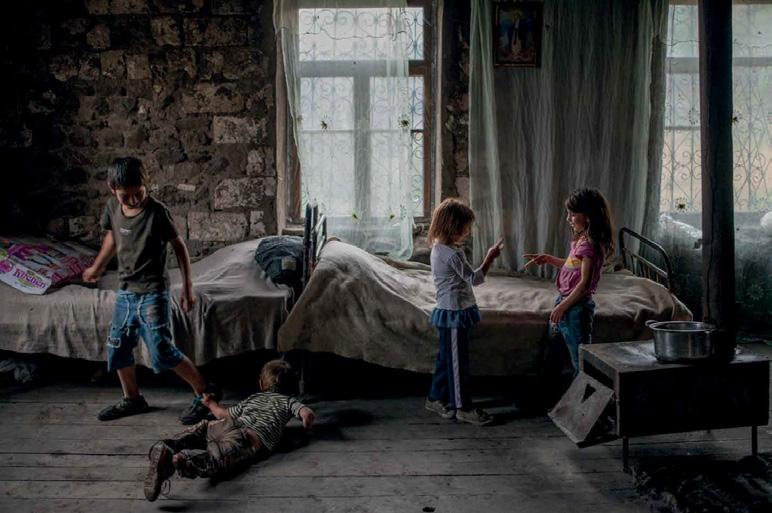

The Ayaryans in Martakert are one of the first families I met. Eduard and Susanna are a strong parenting couple, and their children are especially warm and welcoming. During one of my trips, we climbed a hill above Martakert together, staying there and feeling the beauty until it got dark.
I also spent a lot of time with the Babayans in Stepanakert. We met in 2017 and continued to work together in the following years, during and after the 2020 war. Liana and Gegham had nine children when I met them, and in August 2017, I photographed Liana in the Stepanakert maternity hospital where their tenth child, Movses, was born. Gegham is a religious man, both loving and strict with his children. They have managed to keep things together so well with all their kids through these turbulent years.
Now, at the beginning of 2022, the situation in Nagorno-Karabakh is still unclear. I return when I can, always running along the edge between the familiar and the unknown. Each of my trips to this land has brought me closer to the known.
Anush Babajanyan, excerpt from A Troubled Home, February 2022
© JOHN STANMAYER
 The ruined auditorium of the House of Culture in Shushi. It was shelled in the first days of October 2020, during the 44-Day War in Nagorno-Karabakh. Shushi, Nagorno-Karabakh, October 16, 2020.
The ruined auditorium of the House of Culture in Shushi. It was shelled in the first days of October 2020, during the 44-Day War in Nagorno-Karabakh. Shushi, Nagorno-Karabakh, October 16, 2020.
ASHLEY GILBERTSON WHISKEY TANGO FOXTROT




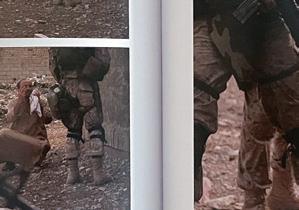

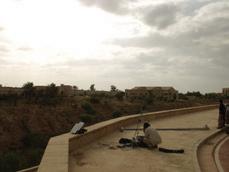

Ashley Gilbertson (b. 1978, Australia) arrived in Iraq in 2002, a year before the US invasion, with no job and no assignments, and stayed there until 2008. Ashley photographed the occupation in its darkest and most violent moments as Iraq descended into unimaginable chaos. He made some of the most iconic images of the war; he also made some of the most ironic. The photograph in this exhibition is drawn from the euphemistically named monograph Whiskey Tango Foxtrot.







War, the old saying goes, is seven parts boredom and one part terror. A soldier mans a post for hours on end, with only the crickets to liven his night. Life in the village carries on, the distant armies no more troubling than the clouds on the horizon. Then, in a flash, all is changed: lives are upended, bodies wrecked, futures destroyed.
But the old formula, while true in a sense, misses war’s most singular aspect: its ability to evoke a wider range of human experiences than any other human endeavor. Heroism, cowardice, joy, deceit, brotherhood, violent death. A nineteen-yearold from upstate New York discovers an unknown capacity for courage as he pulls a fallen comrade from a mosque. A young Iraqi woman feels her life dissolve as she cradles her blinded son. All in an afternoon, all in a flash.




War may be a peculiar mix of boredom and terror, but within those horrifying moments lies the whole galaxy of the human condition.

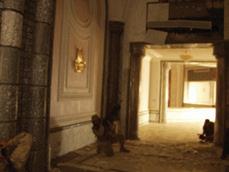


The photographs displayed here depict the full range of human experience called up by the war in Iraq. Ashley Gilbertson, a gifted and fearless photographer, has plunged into this darkest and most ferocious of battlegrounds and found beauty and horror and honor and truth. Scan the faces captured in these pages, of Iraqis and Americans, and of the predicaments they have found themselves in, and see and feel — in your gut — what it really means to be a human being in the middle of a place as tormented and dynamic as Iraq is today.
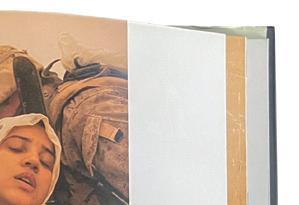









Dexter Filkins, from the introduction to Whiskey Tango Foxtrot, 2007








© AVA PELLOR

A U.S.
Marine slides down the marble handrail in Saddam Hussein’s extravagant palace built in his hometown of Tikrit. The enormous Palace contained rugs and antiquities worth hundreds of thousands of dollars before being looted by Iraqis and U.S. soldiers. Tikrit, Iraq, 2003.
CHRISTOPHER MORRIS ON CHECHNYA

Christopher Morris (b. 1958, USA) is one of the most influential photographers of the 20th century and one of the most celebrated visual chroniclers of war. Morris re-invented and reimagined what was possible with the language of political photography for a generation of photographers and editors while working for TIME magazine during the George W. Bush Administration in the United States, but his colleagues hold him in the highest regard for his visceral and poetic war photography. His career, however, has defied the narrow confines of conflict and politics. An Italian fashion magazine commissioned him after seeing his photographs of Republicans in America, and that led to further work with celebrities and world leaders eager to receive similar unorthodox photographic treatment.


 © CHRISTOPHER MORRIS
© CHRISTOPHER MORRIS
 A Chechen fighter escapes out the front door of the Presidential Palace. He has a long and exposed run out in the open until he can reach cover. Grozny, Chechnya, January 1995.
A Chechen fighter escapes out the front door of the Presidential Palace. He has a long and exposed run out in the open until he can reach cover. Grozny, Chechnya, January 1995.
DANIEL SCHWARTZ

THE GREAT WALL OF CHINA (1987-1988)
Daniel Schwartz (b. 1955, Switzerland) is an enigmatic photographer, documentarian, and artist, and the author of six monographs, including a personal record of his Central Asian travels that incorporates an account of 3,000 years of the region’s history. A prodigious reader and researcher, his photographic projects are driven by rigorous study, disciplined control of craft and technique, and ascetic and monastic practices seemingly at odds with the outcomes, which are spontaneous, responsive, and ephemeral.

The “masked coal worker” (negative PRC87/2-351.7) became an iconic image, but not because wanted it to be. The photograph is part of a series taken during my forbidden journey along the Great Wall of China in 1987-1988, and in 1988 it was chosen as key visual for the Rencontres Internationales de la photographie d’Arles. I did not go to Arles then, but I was told that the poster with the photograph was everywhere. The masked coal worker and other portraits were my contribution to the collective exhibition Chine, shown in the Commanderie Sainte-Luce. The exhibition print and four other copies sent to the Rencontres’ publicity agency in Paris for the festival’s promotion materials were never returned. So I had to make replacement copies for a solo exhibition that toured Europe in 1990-1991. The print included in the VII exhibition See Through the Noise is one of them.

Between 2018 and 2020, undertook an archive research project in view of the exhibition Tracings (Museum of Art, Lucerne, Switzerland, September 30, 2023 – February 4, 2024), as well as toward the forthcoming book Tracings: Photography and Thought (Thames & Hudson). In that context, I made a final edit of the coal photographs created in November 1987 in the sprawling mining district of Datong, Shanxi province, at the heart of which lies the Yungang Buddhist cave complex.

The edit, titled Undermining Buddha, consists of a series of 24 gelatin silver prints, some of them multi-exposure composite prints. It brought to Iight a frame (negative PRC87/2-351.9) that had actually never looked at — the frame that directly follows the “iconic” image. That frame, No. 7, had fulfilled all the criteria important for me back then, and its subsequent selection by the Rencontres as a key visual had seemed further proof of its quality. Since then, the only copy of the 1988 poster that I have hangs in my darkroom. That photograph had acquired its own life. But the blessing had become somewhat of a curse. was blind to the other 11 of the roll film’s frames — with the exception of No. 11, which I had included in a quadriptych with the “iconic” image and two frames from another film.
It is in the nature of the contact sheet that it provides the indisputable context of space and time of every frame captured, together with the realization that each exposure is a record of irretrievable loss. But if nothing remains the same after the moment of the exposure or disappears altogether, something, mechanically or unconsciously, may also be netted in a frame at the instant of its creation; something that emerges much later, and in retrospect appears to be still potent and declarative. It is the cognition that a most difficult but rewarding task for a photographer is the scrupulous review of one’s images with an unbiased and self-critical eye.

Emerging from the contact sheet 35 years after it was captured and printed, the solitary coal worker frame, No. 9, shows an assertive directness (precisely because the woman does not look at you), and it reveals a strength that the “iconic” image does not possess. On the other hand, its discovery did not take anything away from the mystery of the frame that had obtained a privileged place in my work in the first place. The masked smile still holds fond memories of miners and laborers working the loading stations, of donkey cart drivers and coal pickers, all of whom were engaged in incredibly hard and dangerous work; in stark contrast to bureaucrats and security officers, they had welcomed the young, somewhat intrepid foreign photographer. And by being so generous and letting him take their pictures, they allowed him to project himself in a romantic succession of John Thomson, whose Illustrations of China and Its People (Sampson Low, Marston, Low, and Searle; Vols. & II, 1873, Vols. III & IV, 1874) had been a great inspiration during his complicated journey along the Great Wall and which contains a sequence of plates depicting coal mining in the mighty Wu-Shan Gorge.

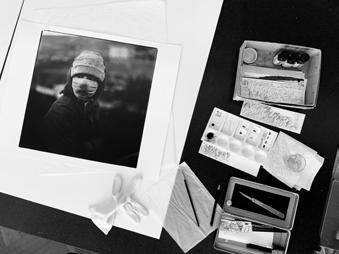
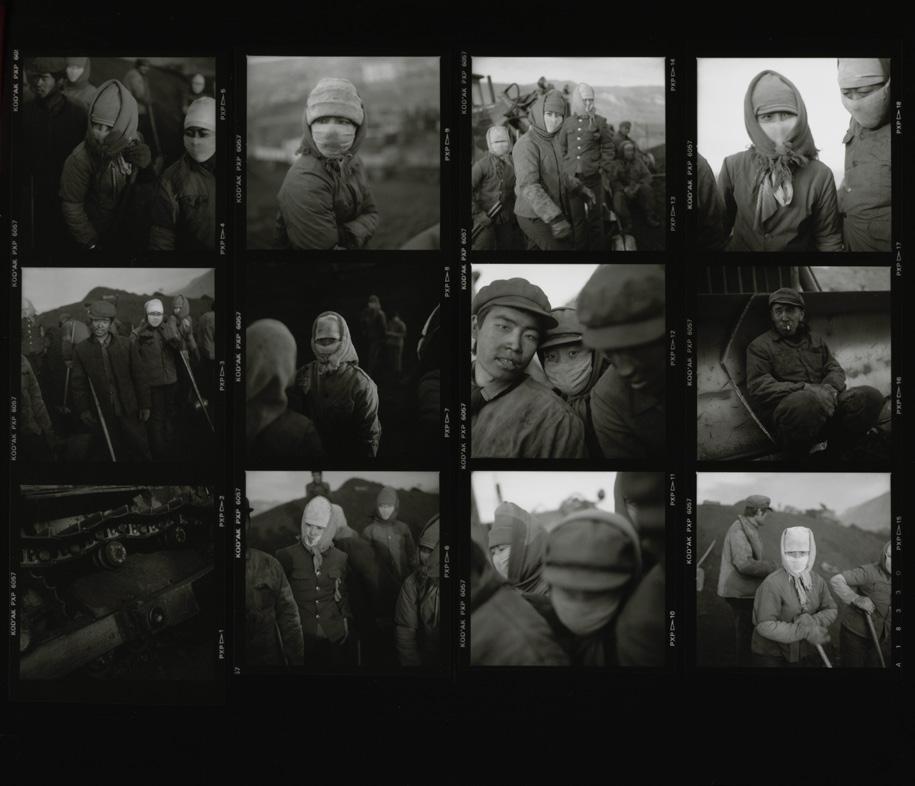 Daniel Schwartz, May 2023
© PHILIP BLENKINSOP
Daniel Schwartz, May 2023
© PHILIP BLENKINSOP
 Coal worker, Yungang Yun loading station, Datong. Shanxi province, China, 20 November 1987.
Coal worker, Yungang Yun loading station, Datong. Shanxi province, China, 20 November 1987.
DANNY WILCOX FRAZIER LOST NATION
COWBOY JOHN: SUICIDE AND THE RURAL GHETTO
Ten years ago, lost thanks to GPS, I drove past a Minuteman ballistic missile site, down a long dirt driveway, and ended up on what Julie Long, John Neumann’s girlfriend, described as a “broke down horse and cattle ranch.” Eight straight years of drought brought me to the badlands of South Dakota, a region rooted in the romantic folklore of the American West. The Neumann Ranch took in all forms of drifters; the disenfranchised, dirt-poor, and mentally ill: veterans, addicts, criminals. No judgment from John; instead, welcome and whiskey. checked the box on several of John’s prerequisites.
John Neumann shot himself on June 9, 2019. He left behind a six-month-old son, Stetson, and fiancée, Tabatha Swartz. John is the cowboy under the busted pickup in my most well-known photograph from the Great Plains. John was proud of that image. It was recognition that his life, with all its rusty edges and broken bumpers, was also something beautiful.
Suicide is personal, part of my life since I was a teenager. Rural America is seeing a dramatic rise in suicides, the rate now 25% higher than in cities. Factors pushing the increase in rural communities include poverty, low income, underemployment, isolation, neglect, lack of access to mental health care, and the stigma that mental health treatment has in rural culture.
John suffered from ankylosing spondylitis, a chronic inflammatory disease where the immune system mistakenly attacks healthy joints. “John was always hurting because of his joints,” says Tabatha. John and Tabatha tried to get John to specialists who could help, but the waiting list was a year for the one doctor in their region. John was spending $600 a month for insurance so that he could receive medical care that was 12 months out of reach. “It was very physically painful for John, and he had tried different ways to control the pain, but we weren’t rich. John was just waiting, just waiting all the time, and he was tired of it,” Tabatha says. “There was no access to the care John needed. Maybe down the road [there would have been], but John didn’t wait long enough.”
Documentary photographer and filmmaker Danny Wilcox Frazier (b. 1970, USA) focuses his work on marginalized communities in and outside the United States. His work is centered on the Midwest and his home state of Iowa and is born from a commitment and love for his neighbors and community. He photographs people struggling to survive the economic shift that has devastated rural communities throughout the parts of America disparaged and misunderstood by so many in the USA and abroad.

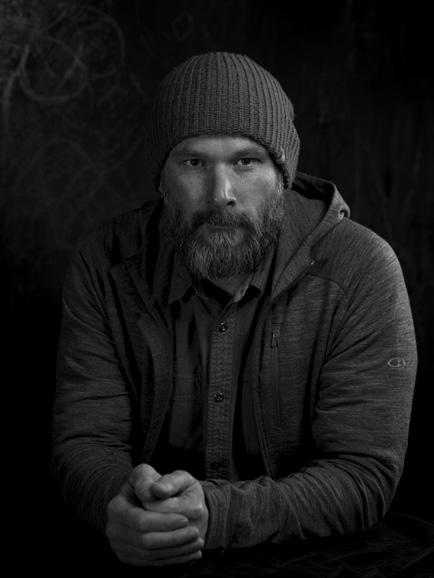
With his photographs from Iowa, Frazier documented those individuals continuing to live traditional lives in rural communities across the state; people challenged economically but often unwavering in their conviction to stay. His work acknowledges isolation and neglect while also celebrating resilience, perseverance, and strength. Frazier is the director of the Daily Iowan Documentary Workshop and advises photographers and filmmakers at the University of Iowa’s independent college news organization, The Daily Iowan.
While trying to understand John’s death is a heartbreaking daily reality for Tabatha and all those who love John, there are many complex societal issues that led to his suicide.
In the remote communities surrounding the badlands of South Dakota, which includes the Neumann Ranch, access to health care and the money to pay for it are real barriers. The system failed John. “It was all about pain for the most part, physical and mental,” says Tabatha. “John’s body hurt so much, he didn’t want to be here.” Maybe if the care that John needed were readily available, his pain could have been managed. Maybe if our society valued access to health care for all, no matter wealth, race, or location, suicides like John’s would fall in number. Until we work together to find solutions for those outside of the ultra-wealthy ranks, the impact of wealth consolidation will continue to take loved ones, like John, from us all.
© JUSTIN MCKIE
Danny Wilcox Frazier, 2020
 John Neumann works on an old pickup truck at Neumann Ranch, a place his girlfriend Julie Long calls a broken-down horse and cattle ranch. John took his life on June 9, 2019, in part due to the lack of medical care in his remote region on the Great Plains of the United States. Rural America is seeing a dramatic rise in suicides. Studies show that the rate of suicide in rural counties is 25 percent higher than major metropolitan areas. Cactus Flat, South Dakota, 2008.
John Neumann works on an old pickup truck at Neumann Ranch, a place his girlfriend Julie Long calls a broken-down horse and cattle ranch. John took his life on June 9, 2019, in part due to the lack of medical care in his remote region on the Great Plains of the United States. Rural America is seeing a dramatic rise in suicides. Studies show that the rate of suicide in rural counties is 25 percent higher than major metropolitan areas. Cactus Flat, South Dakota, 2008.
ED KASHI AGING IN AMERICA
for a world filled exclusively with leisure, was the first step toward blowing apart the traditional extended family. Decades after the first Florida migration, we are paying dearly for the price of Eden.
Of course, an age-segregated society is completely unnatural. It defies all the innate impulses of clan, family, hierarchy, and survival. That’s probably why as a society we are continually searching for ways to reinvent the social order and find alternatives to the traditional extended family. After several years of working on this project, it dawned on me that what Ed and were documenting wasn’t a series of isolated groundbreaking programs or individual life stories. We were witnessing the evolution of new communities that are evolving to meet the needs of the elderly. Whether it is foster families for senior citizens or geriatric wards in prisons, RV clubs for widows and widowers or multigenerational daycare centers, these situations are actually variations on the family portrait. They represent a reconfiguration of community.
With these extended years there is a huge range of experience, attitude and ability. Then there’s the health issue, separating the vital from the prone, self-sufficient from the dependent, the young-old from the old-old. These differences dictate which version of old each person inhabits and at what time.
A powerhouse of energy and creativity, Ed Kashi (b. 1957, USA) is a photojournalist and filmmaker dedicated to documenting the social and geopolitical issues that define our times. In addition to photography and filmmaking, Kashi is an educator and leading voice in photojournalism, documentary photography and visual storytelling. Together with his wife, Julie Winokur, he embarks on long-term projects that delve into questions that explore our essential humanity. “Aging in America” took eight years to complete, and resulted in a traveling exhibition, documentary film, website and book.

AGING IN AMERICA: THE YEARS AHEAD
We live in an age-segregated society. Teenagers leave home as early as possible, young families rear their children in relative isolation, and retirees seclude themselves in senior ghettos (albeit ghettos with golf courses and gatekeepers). The workplace is dominated by twenty-year-old techno-wizards who drive our race to the future, while retirement communities forbid grandchildren as permanent residents because they disrupt the pace of life.
Mobility, which is a uniquely American ethos, has sent us ricocheting from coast to coast, creating our own communities rather than being tethered to family, class, or tradition. As a result, we have chosen to leave our birth families behind, choosing instead to congregate with our peers. As a result, we have created a world where the generations inhabit separate, parallel universes, and rarely the twain shall meet. In fact, the generations have become so alienated that a journey into the world of our elders is like venturing through foreign territory.
Ed and I first became aware of this phenomenon when we had children. When our son was born, I realized I suffered from zero exposure to babies, and I joined the legions of modern women who read books to decipher motherhood. Then came the rude awakening that our previous social lives were banished to the realm of nostalgia. It quickly became apparent that we were also alienated from the universe of elders. We had no one over 50 in our immediate circle and we were sorely lacking mentors. Our children barely had any exposure to an entire generation, and every time we did interact with a man who had silver hair and wrinkles, our daughter would say, “Poppy,” the
name she calls her one surviving grandfather. In the meantime, across the country, my 77-year-old father had started spending winters with his girlfriend in Florida, where the only young people he interacted with were serving him meals or renting him irons.
Aging in America has taken us into what psychologist Mary Pipher calls “Another Country,” the world of our elders. We have charted this foreign landscape in an attempt to create a visual topography of its peaks and valleys. We have come to discover that it has its own look and feel, which is distinct from our middle-aged lives, and completely removed from America’s youth
culture. We have also tried to understand how the universe of our elders became so remote.
I used to blame youthful arrogance and selfishness for the disenfranchisement of our elders. I assumed that young people just weren’t willing to assume the responsibility of caring for their parents and grandparents, and this was a result of an alarming plague of disrespect. But have come to realize that our elders set the whole dynamic in motion. They are largely responsible for the way our culture has evolved. The advent of the retirement community, where elders choose to leave their offspring behind in exchange
Our lives have been altered by immersing ourselves in this work. It has taken a psychic toll at times, and then rewarded us tenfold by expanding our perceptions to include the whole life cycle, not just the part we inhabit or the youth-driven culture that confronts us daily. Unlike working in foreign countries, even impoverished or war-torn ones, this project has forced us to confront our own mortality every day. It has been a tutorial in how to live one’s life, and what to avoid.

Life comes. Life goes. And in between is this majestic arc of experience. We happen to be living at a time when the arc’s final curve has been given a graceful extension. We’re still struggling to figure out what to do with it. We hope that by sharing this work, we will be able to impart a greater acceptance for the aging process. Growing older is not the domain of the elderly; they don’t have a monopoly on this phase of life.
Aging in America is a celebration of individuals who have unique lives and fears, dreams and concerns. It is filled with personal histories that have brought these people to their own place in the pantheon of old age. Through these individual stories we are able to draw parallels to our own lives while peering through the window at universal themes.
Ultimately, our whole society is paying dearly for our elders’ independence. And when the time comes for them to seek assistance, which is happening in record numbers, their lives are so removed from the rest of us that it’s virtually impossible to close the gap. A large proportion of elders opt to be cared for by strangers rather than “burden” their own children, which would be unheard of in other cultures. On the other side of the scale, the baby boomers are grappling with the responsibility of aging parents, which conflicts directly with their careers and the demands of parenting their own children.
©
TOMAS VAN HOUTRYVE
Julie Winokur, excerpt from Aging in America, 2003
 Maxine Peters, 90, passes away at home surrounded by her family, friends, and hospice aides, after a long battle with Parkinson’s Disease and dementia. In many parts of rural America people still live and die, the old-fashioned way. The Hospice Care Corporation, based in West Virginia, sends health workers into rural homes to make sure that people can meet a dignified end, surrounded by their families and loved ones. Gladesville, West Virginia, October 9, 2000.
Maxine Peters, 90, passes away at home surrounded by her family, friends, and hospice aides, after a long battle with Parkinson’s Disease and dementia. In many parts of rural America people still live and die, the old-fashioned way. The Hospice Care Corporation, based in West Virginia, sends health workers into rural homes to make sure that people can meet a dignified end, surrounded by their families and loved ones. Gladesville, West Virginia, October 9, 2000.
ERIC BOUVET UKRAINE: WAR DIARY
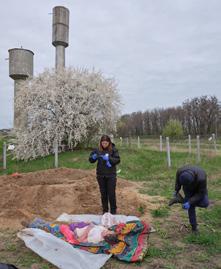







Eric Bouvet (b. 1961, France) lives and works on the edge. When he is not carrying 20kgs of 8x10 large format film cameras on his back to the highest Alpine peaks, he is a tireless photographer of conflict, social upheaval, politics, and culture. His photographic oeuvre is one of the most diverse in VII. Eric is a photographer’s photographer lauded by his colleagues for his courage, humanity, and humility for over 42 years in some of the most aggressive and violent territories, from the fall of the Berlin Wall to the war in Ukraine.

UKRAINE 2022 THE SHAME


The first scene, in the no-man’s-land between Poland and Ukraine, was left without image. How many are they? Hundreds of eyes peering through the mesh of fence topped with barbedwire. walk up this chain of frightened beings against the grain, first shock, incomprehension. The two guards accompanying me order me to keep moving without stopping. Without photos, there’s no proof, so we will have to do with words. Stacked together in the cold, they huddle together to keep some heat in the night that is about to lower its dark, icy curtain. They are not animals, just humans, but they were not born white, just black. Most of these African students, like everyone else, are fleeing war. Not just this war, but another one, that of their own country. But already the border guard, contemptuous, is saying to them: “Go get a gun and fight.” On the border, February 28.
THE EXODUS
Thousands are fleeing. Coming from all over, they are there, clumped together, carrying packages, suitcases, children, animals, pulling their parents and grandparents. The platforms are packed, and so are the trains. Mostly women, children, and the elderly, as men are no longer allowed to leave the country. Alone, many of them stand haggard on the platform, watching the train disappear into the distance, taking with it the promise of elsewhere for their loved ones. At the end of the platform, a man staring into the water murmurs, “This may be the last time I see him.” He has just left his child. Kyiv, March 5.
THE EVACUATION
Just two planks to leave hell. A thousand people from Irpin, Boutcha, and the surrounding area ventured, on foot, towards this long straight line, sometimes bombarded, sometimes under the yoke of snipers, to reach this life-saving passage. It is a narrow gully under the destroyed bridge over the river. Everything is black, an amalgam of soot, gunpowder, earth, dirt, concrete, and iron.
Dragged in blankets, carried at arm’s length, huddled in wheelbarrows, the old people from the hospice were evacuated thanks to the strength and courage of a few. The fear in their eyes cannot be described. A son carrying his mother shouts to anyone who would listen: “There are dead people everywhere.” Like the others, shocked by the sight of human misery all around me, I pay no attention to it. As it turned out, the man’s words were true. Irpin, March 6 to 10.
THE DISAPPEARANCE
Hanna will die this afternoon. She will leave behind a 14-yearold boy and two daughters aged 12 and 10. Yet that morning, her husband was still begging her to leave with their children. But Hanna doesn’t want to, for Olga, her mother, an old woman who can no longer walk. She cannot leave her, even though her block of flats, where the family lives in one shared room, is on the front line. An underprivileged neighborhood, a neighborhood where people tell you to “go where? Where to? Why? This is our home.” Olga has stayed in this flat, with her cat and her tears as her only company. The father, after burying his wife, fled with his children. Olga will shout before leave her: “My neighbors are accusing me of killing my daughter.” Irpin, Sunday, March 13.
A BREEZE OF FREEDOM
I meet up with a Ukrainian friend, Vasyl, who is leading a rescue team at the front. He takes me on board his convoy of over four hundred military personnel. We cross northwards in pursuit of the retreating Russian troops. As we pass through the villages, the convoy is greeted by shouts of joy, tears, and thanks. Inevitably, I am reminded of the images of the American liberators on the roads of France in 1944. I am the only one to witness this convoy of freedom. The soldier driving my vehicle had tears in his eyes: “I love my country, we’re going to win this war for the freedom of all these people.” Poroskoten, Friday, April 3.

THE HORROR
The pain of a mother who, a few days after burying her daughter, must comply with the instructions of the forensic police and attend her exhumation in order to undergo an autopsy. This is what it takes to document future war crimes trials. There are many men and women who have to recognize their loved ones by a piece of clothing, a piece of jewelry or a pair of shoes, buried in a hurry, some in a garden, some in a field. Tatiana was killed by a large-caliber shot fired from a tank positioned more than 500 meters away. After passing through two fences and the wall of her house, the child, crouching in a corner to protect herself, was mortally wounded. She was 10 years old. “I want all their children to be killed!” cried out the mother as she left the cemetery. Borodianka, Monday, May 2.
RESILIENCE
The Ukrainian army has just retaken the north of Kharkiv, on the eastern front, pushing the Russians back towards the border, some ten kilometers away. All that remains after their passage is a land of desolation. Villages bombed, looted. However, little by little, the inhabitants returned. They are even “happy” to be home again, even if the roofs have been ripped open and the walls are miraculously holding. They know, however, that the Russians may come back. There is no more running away. Despite the kidnappings of men of whom the villagers have no news, despite the daily bombings that sow random death, despite the thefts, despite the crimes, despite the rapes. They sit in the sun, serene. This exasperates a young army lieutenant: “Can you believe it, they’re coming back under the bombs to pick up their fucking potatoes...” Prudyanka, north of Karkhiv, Friday, May 13.
Eric Bouvet, diary extracts, Ukraine, 2022

ans, repris armes. Arrivé février non loin d’Irpin, une banlieue de capitale. est d’engagés volontaires. suis leur entraînement express. Lors demande accompagner refuse. Les journalistes sont pas accéder aux combats. Cela
ALviv, plus grande ville l’ouest pays, toutes vêtements provenance de Pologne, transitent par centre heures sur 24, jours bibliothèque municipale, confection. gigantesques métiers tisser servent confectionner filets de combat. Les petites mains résistance airent tous classes d’âge, leurs fascinant voir peuple qu dresse pour défendre liberté faisant bloc derrière Zelensky. disent plupart citoyens recouvertes d’un monticule de leurs courses, promènent leur Ceux des quartiers plus © CERISE BOUVET

BORODIANKA, police criminelle
peut s’assimiler censure. décide donc raconter frontière avec Pologne, une beaucoup réfugiés partent gare de Kyiv. Là-bas, foule, bousculade panique. Sur quais, très peu policiers, juste quelques contrôleurs qui pas surchargés. Certaines scènes sont déchirantes. père pose d’adieu. Depuis février, hommes 60 AIrpin, nord-ouest capitale, sur détruit tout début mars par Ukrainiens pour ralentir sont transportés brouette dans draps servant petite valise, voire un simple dos. Leur enfant sous bras, millions de réfugiés franchie. L’exode plus n’est pas fini.
pas les moyens partir. puis, campagne, entend, au loin, les bruits guerre. les champs… Autant traces Des nuages de fumée noire obscurcissent l’horizon. Tueries, viols, saccages, crimes guerre… j’ai assisté l’humiliation publique trois hommes, ligotés poteaux, pantalons baissés sur chevilles. Début les premiers charniers sont découverts des centaines de corps de civils déterrés. Tout près, police nationale sont appelés par les habitants. Un cadavre va-vite, fond son jardin… Parfois, les familles doivent ellespour faire gagner du temps aux équipes d’investigation. raison d’une dizaine de rendez-vous par dépouilles, enroulées dans des simples couvertures, sont en état emportent, dans leurs véhicules, les corps morgue plus mort côtés, dans cercueil. Dignité solidarité. vie Depuis l’invasion russe, les Ukrainiens invitent médias qui est l’appellation russe.

Le 24 février, l’armée de Vladimir Poutine envahit l’Ukraine. Pour Polka, le photographe Eric Bouvet est retourné dans le pays où il couvert, en 2014, la révolution de Maïdan. Pendant plus de deux mois, il documenté les conséquences du plus important conflit en Europe depuis la Seconde Guerre mondiale. L’exode, les destructions, les crimes de guerre… mais aussi la mobilisation d’une population, civile et paramilitaire, engagée derrière son président. Un reportage sur les conditions de survie des Ukrainiens, à un moment où le front était inaccessible pour la presse. Reportage photo et texte Eric Bouvet pour Polka Magazine AUX ABORDS D’IRPIN, UKRAINE, LE 25 AVRIL. Le nouveau cimetière on l’appelle dans les environs, accueille de nombreuses tombes fraîches au milieu d’une forêt de pins. Photos Eric Bouvet VII pour Polka Magazine. Page suivante. GARE DE KYIV, Légende Dio repelist, nihici quatur, cullectam, sint seque cullectam, sint seq cullectam, sint cullectam, sint seq cullectam, sint par Parfois, les familles exhument elles-mêmes leur proche pour accélérer les investigations C première quarante carrière front. Dès que Poutine lancé son ensive l’Ukraine, pays. 2014, j’ai rencontré Kyiv* nombreux citoyens pro-européens se battaient informaticien nommé Vasyl. Aujourd’hui âgé
UKRAINE CARNET DE GUERRE
 The new cemetery outside of the city in the middle of the woods. Irpin, Ukraine, April 25, 2022.
The new cemetery outside of the city in the middle of the woods. Irpin, Ukraine, April 25, 2022.
ESPEN RASMUSSEN EARTHQUAKE IN KASHMIR

















Espen Rasmussen (b. 1976, Norway) grew up steeped in news — both of his parents worked for newspapers. When his mother worked the night shift at the local paper as a designer, his father, a reporter and editor, brought his children along to events that he had to cover live, like fires and other emergencies. In some ways, it was inevitable that Espen would become a journalist. He lives close to Oslo, Norway, and works as a photo editor and producer at the The Hub, the online magazine and long-format desk at Norway’s biggest newspaper VG, but his relatively placid desk job is punctuated by long stints abroad photographing and immersing himself in communities at the extremes of life: refugees struggling to survive across the globe for his project TRANSIT; workers grinding out an existence in the Rust Belt of the USA for Hard.Land; and violent right-wing extremists in America and Europe for White Rage.
Rasmussen lectures in photography at universities, frequently gives presentations at photo festivals, and appears before a wide range of other audiences.


This image is important to me for many reasons. My report from Pakistan was one of the first international stories I did that really managed to break through the noise and reach a wider audience, in no small part with the help of the award in World Press Photo. It is also important for me because I think it shows a resistance and a will to survive in a situation that is almost impossible — most homes and infrastructure in this area were destroyed by the earthquake, but people managed to continue. This image, think, shows how important belief can be in people’s lives and in the wish to survive.
Espen Rasmussen, June 2023

© ESPEN RASMUSSEN
 Over 3,000 people gather for Friday prayers at the ruins of the main mosque, one of the towns worst hit by the Kashmir earthquake. Three months after the October 2005 earthquake that devastated parts of Kashmir, hundreds of thousands of people were still homeless, many living in tents and collapsed buildings, facing icy winter conditions in the mountains. Balakot, Kashmir, January 27, 2006.
Over 3,000 people gather for Friday prayers at the ruins of the main mosque, one of the towns worst hit by the Kashmir earthquake. Three months after the October 2005 earthquake that devastated parts of Kashmir, hundreds of thousands of people were still homeless, many living in tents and collapsed buildings, facing icy winter conditions in the mountains. Balakot, Kashmir, January 27, 2006.
FRANCO PAGETTI VEILED ALEPPO
Franco Pagetti (b. 1950, Italy) started his celebrated professional life as a chemist and “accidentally,” in his words, became a fashion photographer after a friend asked him to work as her assistant. After working in fashion for Vogue and other magazines in Italy, in the late 1990’s he pivoted and focused on conflict, first in South Sudan and, shortly afterwards, Afghanistan, where he met Gary Knight, James Nachtwey, John Stanmeyer and Ron Haviv for the first time. He committed himself to documenting the wars in Afghanistan and Iraq with distinction and soon brought his colorful and charismatic personality to VII. He returned to the fashion world to work for Dolce & Gabbana at the behest of Domenico Dolce and worked on numerous high-profile campaigns. This work from Syria is imbued with the sensibilities of both his fashion and conflict photography; it’s where all the creative and cultural influences of his life in photography converge.

cleaning and drying into the bliss of wearing is, in such circumstances, almost inconceivable. In both instances the hung-out washing stands as a billboard advertising humankind’s amazing capacity for persistence.
Walking through the old neighborhoods of any city with decent weather, you suspect the sheets hung out to dry might be the unofficial national flags. Actually, the weather doesn’t even need to be half-decent. Nothing is so depressingly expressive of my native land (England) as the sight of laundry hanging out wetly for days on end, going from soaking to soggy to damp — and back to soaking without having achieved the mythical goal of dryness. And then there are cities where the air pollution is so bad that drying quickly turns into its near-anagram, dirtying. Escape from the samsara wash-cycle of
So they strike multiple chords, Franco Pagetti’s series of photographs from Syria, Veiled Aleppo, the sheets are no longer laundry at all. Perhaps they never were — and yet still they sway and blow as flimsy proof of the reliance of everyday life in the face of near-total ruination. The opposite of screens around a site where construction is in progress, these sheets demarcate areas of almost completed destruction. Their practical function is, presumably, to offer cover from sniper fire (the ever-present danger of which is suggested in one image by an advertisement featuring a row of painted eyes). The flimsiness of the protection is in striking contrast to the sturdiness of buildings and metal shutters — except that, in the face of the sustained onslaught of modern weaponry, concrete and steel are scarcely more resilient than cloth. The buildings are often reduced to bulky poles holding up the washing lines (which, I’m guessing, once served as phone or power lines).
Going back to the earlier mention of flats, it is a point of military honor never to lose or surrender the regimental standard or colors — but an immaculate flat is valued less highly than one that displays the price paid for its continued survival. Ideally the standard is reduced almost to rags as proof of valor, testament to sacrifices made in order to retain it. In some instances these ragged emblems are stained with the blood of those who
died preserving them. Moving from the martial to the domestic, bloodied sheets are sometimes displayed after a wedding night as twin proofs: that the bride was a virgin and that the marriage has been consummated. Our thoughts are urged in this direction by Pagetti’s deliberate use of the word “veiled,” hinting at both the lithe appeal of orientalist erotic fantasy — as in, the dance of the even veils — and the subordination of women that is an intractable feature of Islamic fundamentalism.
The difficulty posed by Syria for the United States is how to intervene and militarily support attempts to oust a dictator (and establish democracy) while not abetting that which is inimical to the continued progress of the species (militant Islam). The alternative — to do nothing — is, as the saying goes, to leave the rebelshanging out to dry. Amazingly, Pagetti’s pictures seem to illustrate this difficulty: at first glance the viewer could be forgiven for thinking that one of the pictures shows an improvised version of the Stars and Stripes. But it’s not, of course. It’s the stripes and stripes, the visual equivalent of being stuck between a rock — of which there is no shortage — and a hard place.



So perhaps these veils are best regarded as symbols of the pictures themselves, of the death throes not of a city but of film, of the days when prints and contacts — contact sheets — hung in the studio so that the photographer could see what had been captured or missed: evidence of things seen and unseen.
Geoff Dyer, “Franco Pagetti: Aleppo, Syria, 19 February 2013,” See/Saw: Looking at Photographs 2010-2020 (Graywolf Press 2021)


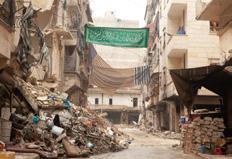
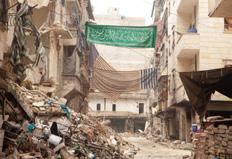











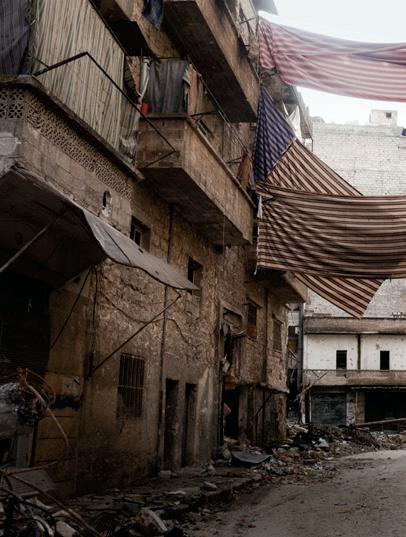

©
SARAH SHATZ
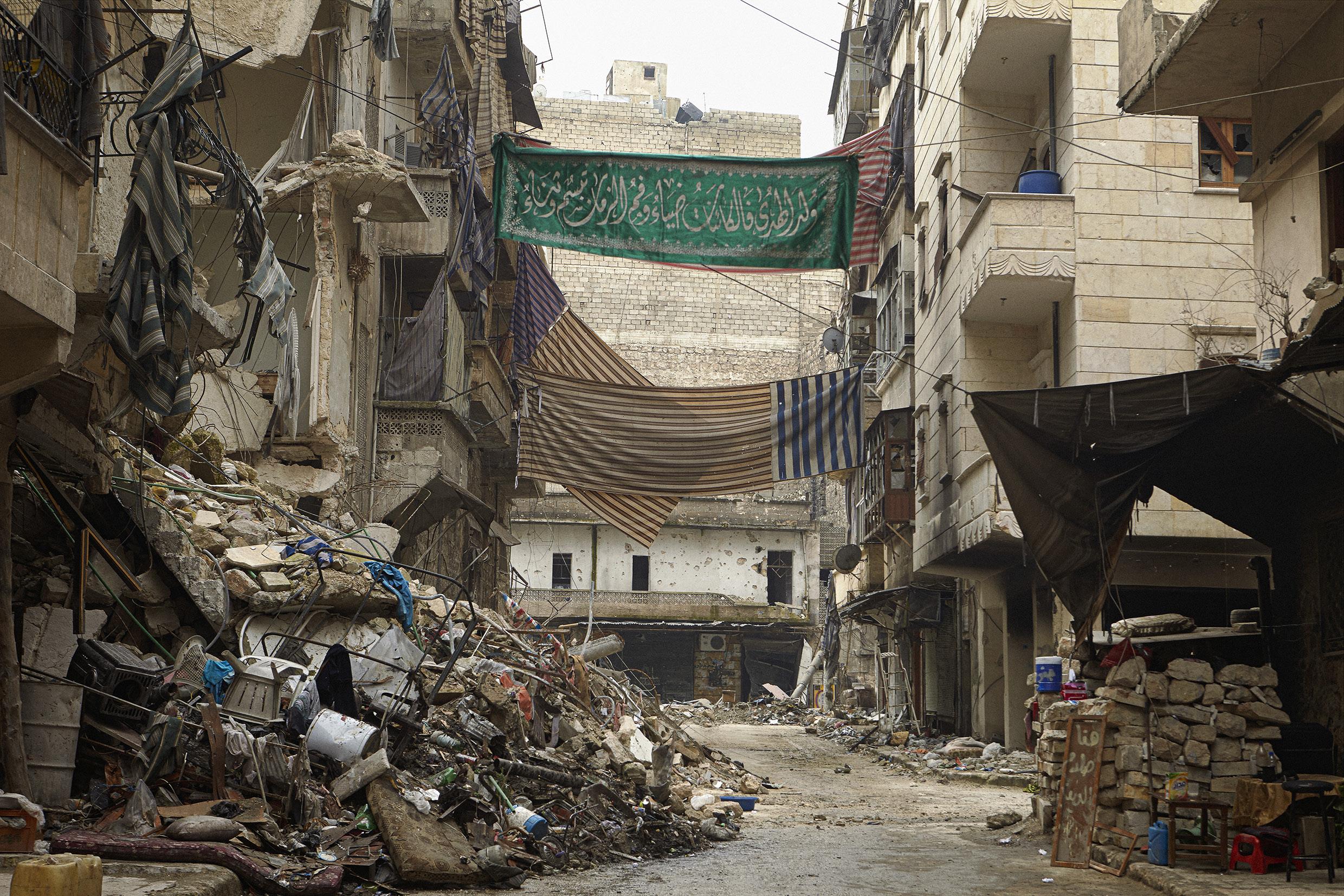 In the past, residents hung curtains to protect the family’s privacy, to protect the home from wind and sand storms, and to protect from the heat. Now the curtains protect them from Bashar Assad’s snipers, and are visible in all the frontlines in the city. Salah Aldin neighborhood front line, Aleppo, Syria, February 10, 2013.
In the past, residents hung curtains to protect the family’s privacy, to protect the home from wind and sand storms, and to protect from the heat. Now the curtains protect them from Bashar Assad’s snipers, and are visible in all the frontlines in the city. Salah Aldin neighborhood front line, Aleppo, Syria, February 10, 2013.
GARY KNIGHT INVASION: THE BATTLE FOR DYALA BRIDGE, IRAQ
An essay on war photography originally written by Geoff Dyer in response to the War/Photography exhibition curated by Anne Wilkes Tucker at the Museum of Fine Art, Houston in November 2012. Dyer has recently written a history of photography called See/Saw: Looking at Photographs 20102020 (Graywolf Press 2021). This essay is used with the kind permission of the author.

Susan Sontag’s book Regarding the Pain of Others concludes with a discussion of Jeff Wall’s huge photograph Dead Troops Talk (A Vision after an Ambush of a Red Army Patrol, near Moqor, Afghanistan, Winter, 1986). “Exemplary in its thoughtfulness and power”, this image of a “made-up event” was constructed in Wall’s studio. “The antithesis of a document”, the picture’s effectiveness derives, in other words, from the fact that it is a fiction.
But what effect does this have, in turn, on combat photographs that are documents? Are they diminished or enhanced by comparison with Wall’s mock-up?
Consider, for example, Peter van Agtmael’s well-known photograph of a line of US troops sheltering from the downdraft of a helicopter in a rocky grey landscape in Nuristan, Afghanistan, in 2007. Its compositional resemblance to Wall’s image suggests that the fictive can set a standard of artistic authenticity to which the real is obliged to aspire — and can still, accidentally, achieve. At the same time, its similarity to W. Eugene Smith’s shot of Marines sheltering from an explosion on Iwo Jima in 1945 testifies to its place in the heroic tradition of documentary photography.
situational terms he is the least important figure there; in every other way, he is the most important figure in the picture, its unavoidable focus.
The dead man is also the epicentre of the remarkable stillness of the picture, a stillness that emanates from and converges on him. (The slight blurring of the leg and foot of the soldier walking across the scene shows that a relatively slow shutter speed was enough to capture everyone else with near-perfect clarity.) There is a lot of activity — a lot going on and a lot to be done — but there is almost no movement. There is thus a kind of double stillness: the stunned stillness that comes after a battle and the stillness of oil painting, a stillness that does not stop time (as happens in fast-shutter-speed photography) but contains it. Oil paintings imaginatively recreate the swirl of action and battle with the steadiness of observation the painter would bring to bear on a still life (a bowl of fruit, say, or flowers). Photography can record actual combat but only with the kind of urgency and blur of Capa’s famous picture of a Republican soldier being killed in the Spanish Civil War or — for disputed reasons — his shots of the D-Day landings. Only in the aftermath of extreme violence can the twin strengths of photograph and oil painting be combined in this single extended moment.
It is not at all unusual for news photographs to echo the paintings of the past, either deliberately or accidentally. In 1967 John Berger famously pointed out the similarities between the photograph of the corpse of Che Guevara and Rembrandt’s painting of The Anatomy Lesson of Professor Tulip. A year later James Louw photographed Martin Luther King’s friends and associates on the balcony of the Lorraine Motel in Memphis, after he had been shot.
As an aspiring young photojournalist in South East Asia in the 1980’s, Gary Knight (b. 1964, UK) supplemented his meager picture sales by selling his own blood. In the Balkans, he developed his career working on the frontlines in that violent civil war, where he met lifelong friends Alexandra Boulat, Ron Haviv, Christopher Morris, and James Nachtwey, who, with Antonin Kratochvil and John Stanmeyer all became founding members of VII Photo Agency. Crisscrossing the globe for Newsweek and building networks everywhere, he saw the demise of the traditional photo agency model and the early signs of decline in print media. His determination and vision led to the creation of VII. As CEO of The VII Foundation and VII Academy, he leads a team which supports fiercely independent journalism and trains and mentors a new generation of journalists in the Majority World, who are best placed to tell their communities’ stories to the world.

April 7, 2003: 0430 wake up, pack the car, squeeze a foil envelope of peanut butter into my mouth, drink a mouthful of warm water, fold my laundry and drive to 20 yards short of the bridge.
An APC is parked on the left of the bridge, mortars on the right. Outgoing 155’s light up the palm grove on the north side of the river, mortars and machine guns take care of the residential area on the left. The usual cocktail of overwhelming firepower before an assault. I guess they are going for an infantry assault on the bridge sometime soon. see mortars on the right and wander over to take some photographs.
Iraqi 155’s walk towards our position, rows of exploding shells moving in a line until they land right on top of us, metal flying everywhere, confusion: incoming and outgoing, it all feels like incoming it’s so damned loud and so close. A Marine APC explodes 10 yards away; the turret flies in the air like a plastic toy. I run across the road through a cloud of dust and black diesel smoke. 2 dead Marines on the ground, the wounded crying for help. Marines not wounded swarm the area. The tension and anger rise. Enrico and I photograph.
Kilo and India companies start to move, run for the bridge, step over the dead boy covered in flies that Jack shot last night and span the holes in the floor with boards. Grunts charge the northern banks. Everyone is shouting, and bullets cut through the clouds of smoke and dust.
Iraqis in every possible death pose litter the street, fried to a crisp with their clothes burned off, rigor morticed, some intact
— delicately pierced by a sniper round or exploded and melon red, fresh, bleeding. The road is filled with shards of metal, and concrete from destroyed buildings — like a lava field it’s hard to walk without twisting your ankle. It’s quiet now and the pain and violence are overwhelming.
Shrapnel and concrete crunch underfoot as the Marines move house to house. An old grey-haired civilian is lying slumped with his head resting against the steering wheel of his truck, he looks like my grandfather Dick, the difference being that Dick died of a stroke and didn’t end up losing the back of his head. I imagine his wife waiting for him to return from work.
We reach the end of the block, bridgehead for the Division now secured. Kilo takes the open ground and digs into the dirt on the west side of the road, India is still moving through the palm grove on the east. Marine snipers take up positions on either side to hit anyone coming our way.
Heavy air strikes and artillery north of us, very close. A blue minivan approaches from that direction, the snipers fire warning shots, and it turns away. A white pickup approaches, the snipers kill the driver, a soldier in uniform, fair game. The blue minivan returns, the sniper’s fire warning shots but the grunts open up simultaneously with everything they have, the minivan bursts like a cherry, Captain Norton screams “Ceasefire — wait for the snipers” but it’s too late. Five civilians are bleeding to death, isolated.
Gary Knight, Journal entry, “Invasion: The Battle for Dyala Bridge”
It reminds us, also, that George Bernard Shaw’s appeal to photographic proof still holds good, in a battered and shop-worn (as opposed to photoshopped) sort of way, despite the challenge of digital. Shaw said that he would willingly exchange every painting of the crucified Christ for a single snapshot of Him on the cross. “That,” as Magnum photographer Philip Jones Griffiths insisted, “is what photography has got going for it.”
Or is this to miss an important point about Wall’s work, namely its relationship not to photography as traditionally conceived — as a kind of visual stenography — but to the imaginative ambition and reach of history painting? Sontag herself describes Wall’s intentions as “the imagining of war’s horrors (he cites Goya as an inspiration), as in nineteenth-century history painting and other forms of history-as-spectacle.” If van Agtmael’s photograph falls short of the epic scale of this ambition then we can turn to a picture taken by Gary Knight in Iraq in April, 2003. The photograph is actually part of a sequence recording the battle for Diyala Bridge. All of the pictures have the kind of immediacy we associate with photojournalism from Capa and Smith in the Second World War, to Larry Burrows and Don McCullin in Vietnam. Taken together they make up a visual narrative of combat and its aftermath with which we have become wrenchingly familiar. At its heart, however, is a single photograph that contains the larger story of which it is part.
Knight himself has provided a vivid account of the terrifying context in which the picture was made: “This was at the start of the invasion. We were at the Diyala Bridge, which had to be taken by the Marines so they could get into Baghdad. They were the lead battalion, the ones who went on to pull down the statue of Saddam. The opposition were shelling us. It was terrifying – both the actual shelling, and the anticipation of it. It comes in waves so you can see it moving in your direction. One had exploded in the tank. If it had landed on top or a couple of feet over, I would have died.”
In the dead centre of the picture a soldier is pointing — directing our attention — to the corpse that everyone else, with the possible exception of the soldier advancing towards the camera on the extreme left, seems determined to ignore. Understandably: in

It’s a picture of instantaneous journalistic and historic importance but the way three arms are raised, pointing in the direction of the presumed assassin — not, as in Knight’s Diyala Bridge picture, at the victim — mirrors the three brothers in Jacques-Louis David’s Oath of the Horatii (1784).
This, surely, was not in Louw’s mind at the time he took the picture. The parallels, however, are not merely visual. As art historian Hugh Honour writes in Neo-Classicism, David chose to depict “a moment not mentioned by any historian... in which the highest Roman virtues were crystallized in their finest and purest form. This was the moment of the oath when the three youths selflessly resolved to sacrifice their lives for their country.” Or, as King had put it in a speech the night before his assassination, “Like anybody, would like to live a long life. Longevity has its place. But I’m not concerned about that now. I just want to do God’s will.”
While the Louw picture instantly recalls David’s, Knight’s suggests a generalised memory of several paintings without quite superimposing itself on any one in particular. (The overall colour of the picture — a sandy, dusty, light brown that extends to and dulls the glow of the sky — is like the default hue of any numbers of paintings of atrocities, battles and assorted barbarisms in the middle-east: the Orient, as Delacroix and his contemporaries conceived it).
The centre foreground of Napoleon on the Battlefield of Eylau (1808) by David’s pupil Antoine-Jean Gros is dominated by a heap of corpses, around which the rest of the figures are arranged, but the fit is far from exact. Paintings of various scenes and battles from the American Civil War — Charles Prosper Sainton’s Pickett’s Charge, Battle of Gettysburg (1863), say — provide only rough templates. Knight’s Diyala Bridge photograph quotes from an actual event but not from an identifiable painting. It combines the documentary immediacy and evidential power of the best photojournalism with the epic grandeur of history painting.
Geoff Dyer, “The jarring reality and artful beauty of photography,” Los Angeles Times, April 20, 2013
© ALIZÉ DE MAOULT
 Lance Corporal Andrew Julian Aviles from the 3rd Battalion 4th Marines lies behind his destroyed Amtrak a few meters from Dyala Bridge. Our position had been subject to an intense artillery barrage, and a shell had entered the Amtrak through the top hatch. It killed Aviles and Corporal Jesus Medellin. Others were injured. Dyala Bridge, near Baghdad, Iraq, April 7, 2003.
Lance Corporal Andrew Julian Aviles from the 3rd Battalion 4th Marines lies behind his destroyed Amtrak a few meters from Dyala Bridge. Our position had been subject to an intense artillery barrage, and a shell had entered the Amtrak through the top hatch. It killed Aviles and Corporal Jesus Medellin. Others were injured. Dyala Bridge, near Baghdad, Iraq, April 7, 2003.
ILVY NJIOKIKTJIEN

BORN FREE
Ilvy Njiokiktjien (b. 1984, The Netherlands) is an independent photographer and multimedia journalist who has worked all over the world and spent twelve years returning regularly to South Africa for Born Free. She is drawn to stories that show the experiences of distinct communities or groups, in part due to her own unusual background: she spent her childhood living with her large family on a clipper — a merchant sailing ship — moored in Maarssen, the Netherlands, the daughter of a half-Chinese father and Dutch mother who rarely discussed their families’ immigrant heritage. Her own experiences of being somehow different to the then largely-homogenous Dutch community around her drives her to seek out the stories of both otherness and belonging in those she photographs.
JUST TWO PEOPLE CONNECTED
Zakithi Buthelezi (27) notices people often treat him differently once they find out he has a white girlfriend. Friendlier, more interested. It gets him respect. For Wilmarie Deetlefs (24) – his girlfriend – it’s mostly the other way around. “Go get yourself a man of your own color!” she once had a taxi driver snarl at her.
“So you like them darker” or “I see you like your vanilla”, are comments they hear a lot. These may be harmless jokes to the people saying them, but such remarks still frustrate the couple. “They are basically saying this is something out of the ordinary. But it’s not”, says Deetlefs. “It’s just two people connected,” Buthelezi adds.
“But those are little things,” they put it into perspective. “It’s not like prosecution”. Which is what they could have faced under apartheid laws, where interracial relationships were prohibited. “I would have totally sneaked around for you though,” Deetlefs adds, laughing.
LIVING WITH YOUR LEGACY
Five months into their relationship – “a Tinder success story” –Deetlefs hasn’t yet told her parents about it. “The previous relationship I had with someone who wasn’t white, my dad took it so weirdly, strangely personal.
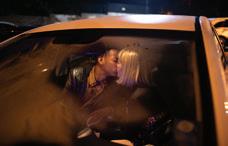


She blames it on the conservative mentality in the small rural town where she grew up, and where her parents still live. “People gossip and say really mean things. That’s why I have no friends back there, and never had friends growing up, because could not connect with those people.”


Deetlefs listens as Buthelezi – grandson to prominent Zulu leader Mangosuthu Buthelezi and destined to one day take over his role – talks about his people’s culture and history. “It’s such a cool legacy to have, that you get to be proud of your culture. I’m happy for you,” she responds.
She never cared much for her Afrikaner background, history and politics, because of how it is associated with apartheid. “Being proud of your heritage is like you support the people in that heritage. For me that’s why can’t be proud to be Afrikaans.”
“You could celebrate the good Afrikaans people,” Buthelezi suggests. “Because there were many that weren’t part of it, like Bram Fischer.” Deetlefs: “I guess… Who was Bram Fischer?”
A CLEAN SLATE

While they recognize not the entire country is like that, Deetlefs and Buthelezi describe Johannesburg – where they now both live – as a “pocket of perfect unity”, where people of different race groups, genders and sexual orientation mix together in ways that would not have been possible during apartheid.


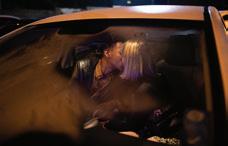










“I think our generation is here to form a reconciliation, like that is our role”, says Deetlefs. “We’re the generation that’s going to completely move away from how South Africa lived”, Buthelezi adds.
“For people in the older generation everything is still so racialist, and apartheid is still thrown into debates. That is over guys, it’s just time to move on.”
South Africa needs a clean slate,” says Deetlefs. “I think that’s our generation. We are the clean slate.”

SOUTH AFRICA’S BORN-FREES: LIVING WITH AN UNEQUAL LEGACY


A generation of youths has grown up since South Africa abandoned its oppressive apartheid system. In 2019 the country icelebrated the 25th anniversary of its first democratic elections, that ended white minority rule, made Nelson Mandela the first black president and gave all race groups equal rights.
“I can do anything I want, study anything I want, go anywhere want. There are no barriers now,” economics students Mzimkulu Ntakana (21) sums up what being born-free means to him. “Born free from what?”, asks Candice Mama (28). “I don’t believe that people can be born free until economic inequalities are set right.”
Mandela’s vision of a thriving “rainbow nation” raised high hopes at the time, but 25 years later many in the born-free generation still struggle. Estimates of youth unemployment [in 2019] ranged between 35 and 50 percent. “If you don’t get a job, you create your own. You need to hustle,” says Innocent Moreku (22), who sells secondhand clothing on the roadside.
A majority of youths interviewed feels white South Africans still have better opportunities. “Their grandfathers and great grandfathers have been working and saving up, whilst our grandfathers have been fighting,” says Zinhle Mfaba (24). When black South Africans do make money, they often have to provide for less fortunate family members, a phenomenon known as “black tax”. Fashion designer Cindy Mfabe (27): “We have to work double time, because we still have all this damage that we have to fix.”
Most say they would be happy to mix with other race groups, but past segregation still holds them back. “I don’t live in a place where I can meet a lot of white people and have white friends,” says Zinhle Mfaba, who lives in Soweto, once designed as a black township and still largely black today. Kevin du Plessis (28): “I have a lot more white friends, because in Gauteng you don’t find that many black kids that speak Afrikaans.”
Many born frees are not interested in voting in elections. Some feel bad about their apathy, knowing their right to vote was fought for, but say the corruption scandals of recent years made them lose faith in politics.

Despite the challenges, many remain optimistic about their future, and that of the country. They feel 25 years was simply not enough time yet to repair the troubled past, and their generation is only a start. Wilmarie Deetlefs (24), who has a black boyfriend: “South Africa needs a clean slate. I think that’s our generation. We are the clean slate.”
Jorrit Meulenbeek and Ilvy Njiokiktjien, excerpt from Born Free, 2019

12 har hollandsk fotojournalist fulgt unge sydafrikanere, der født efter det første demokratiske valg 1994, hvor sorte og hvide lige rettigheder. De kaldes orsiden orsiden orsiden ultur jalmer Larsen ar masser af ucces, men avner sin far Det er på tide, at vi spørger ores børn, hvordan de har det orsiden debat BORN FREE-GENERATIONENS LIV I SKYGGEN AF APARTHEID UDSTILLING DEBAT MUSIK FILM ØL OG PØLSER Se hele programmet på natmus.dk 9. NOVEMBER 2019 MARTS 2020 F rankrigs præsident, Emmanuel Maron, kan se frem en alvorlig samale om EU’s »inhumane«, »uretfærige« og »farlige« asylsystem, når han på andag Paris tager imod sin nye danske ollega, Mette Frederiksen (S). Jeg har vigtigt budskab Macron: har dysfunktionelt flygtningesytem, og det kan ikke blive ved med baat lade køre videre«, siger statsminister ette Frederiksen. tatsministeren vil ophøje det »en ovedprioritet« for sin europæiske dagsrden overbevise EU’s ledere om, sylsystemet skal omkalfatres grundlægende. Tanken udnytte hendes første fficielle besøg Élysée-palæet som startkud for en europæisk kampagne. ette Frederiksen betragter den franke præsident som afgørende potentiallieret bestræbelserne på realisere socialdemokratiske plan om etalere nyt asylsystem, hvor modtageentre uden for EU’s ydre grænser skal væadgangsport til søge asyl Europa. Det bliver ikke nemt, men alt, kan ætte stedet for vores forslag, blive appeløsninger flygtningesystem, om alle enige om ikke fungerer. Det syjeg mærkeligt. Hvis alle enige det ikke fungerer, det er uretærdigt, inhumant farligt, hvorfor alerden så ikke lave det om«, sigerhun. Socialdemokratiet februar 2018 ræsenterede modellen med modtageentre uden for EU, blev det fremhævet, anmark »hurtigst muligt skal indlede dialog med de mulige lande, hvor odtagecenter kan etableres«. asylpolitik Mette Frederiksen vil bruge mmanuel Macron som llieret kampen for et nyt sylsystem. Venstre Dansk Folkeparti forstående overfor tatsministerens strategi. Mette F. vil søge fransk støtte til asylsystem asale retsprincipper er nder pres Danmark. J eg mener ikke, man som poliiker skal på, hvad del efolkningen så ændre mening. Man må have prinipper værdier, som man står inådan sagde generalsekretæren det tyske socialdemokrati, Lars lingbeil, et pressemøde Berlin idligere på ugen. tyske socialdemokrater har egne store problemer med vælertilslutning, men prøv alligevel væle lidt ved de ord. tænk ver, hvor uendelig langt den holding fra den danske politiske virelighed. ngang var det en selvfølge, anmark stod vagt om universelmenneskerettigheder respekerede sine internationale forpligelser. Men så svingede folkestemingen, politikerne svingede den. Bare denne uge kuldkatede de danske politikere flere helt basale grundprincipper. kke bare kan integrationsminiteren administrativt fratage olk statsborgerskabet noget det est basale, der findes. Ifølge nyt ovforslag lægger regeringen også til, at børn, der fødes områder, vor terrororganisation part væbnet konflikt, ikke længere omatisk bliver danske statsborgeANDRE ord: Børn skal straffes noget, som deres forældre har jort. Den slags nedarvet skyld høellers fjerne tider til, og forslaget – som Venstre støtter strider ifølge nstitut for Menneskerettigheder od vores folkeretlige forpligtelser. ed den nuværende danske poliiske virkelighed den slags nærest standard. denne uge erklæreMette Frederiksen, konventioerne mod statsløshed forbindelse syrienskrigerne »beskytter orkerte«. rystende afslørende emærkning. konventioner skal per definiion beskytte alle. Rettighederne niverselle, ikke afhængige af, om tatsministeren finder de enkelte ersoner sympatiske eller beskyttelesværdige. Det er faktisk lige prædet, som forskellen en retstat og bananrepublik. statsministeren og det meste olketinget tilsyneladende har lemt det, frygteligt. Retsstat eller ej? POLITIKEN MENER Søndag rgang 136. Nr. olitiken 70 udgave ww.politiken.dk ortsættes side © JET VAN GAAL
Wilmarie Deetlefs (24, r) together with her boyfriend Zakithi Buthelezi (27, l) on a night out. Five months into their relationship — “a Tinder success story” — the couple often notice people treat them differently once they see they are dating interracially. Deetlefs hasn’t yet told her parents she is dating Zakithi. “The previous relationship had with someone who wasn’t white, my dad took it so weirdly, strangely personal.” She blames it on the conservative mentality in the small rural town where she grew up, and where her parents still live. Buthelezi notices people often treat him differently once they find out he has a white girlfriend. “They treat me friendlier, more interested and with more respect.” Deetlefs: “They are basically saying this is something out of the ordinary. But it’s not.” Buthelezi: “It’s just two people connected.” Johannesburg, South Africa, November 1, 2018.

JOHN STANMEYER SIGNAL
on them, others waving them in the air or just standing motionless. So startled by the unique gathering of fellow human beings, asked Stanislas what they were doing and why they were gathering along the sea at night.
He said these people, mostly Somalis but also people from Ethiopia and Eritrea are in the desperate act of migration. They come to this spot along the beach to engage in what is colloquially known as “catching”—trying to catch an inexpensive signal from neighboring Somalia by using a Somali SIM card in their phones.








was astonished by what we were witnessing — the natural desire that we all have as humans to reconnect to home.
Over the following few days, I would revisit this stretch of beach where, each night, there would be a new gathering of men and women waiting for that moment when all the natural layers would combine.
Speaking to many of them, their stories were always the same: the desire to reconnect to family, asking for support or updates on emigration papers from family or friends already living in Europe.
John Stanmeyer (b. 1964, USA) is an unorthodox and creative force of nature who embarks on complex and very (very) long and ambitious projects. This image was made during the Out of Eden Walk for National Geographic, a unique and epic photographic journey on foot, tracing the footsteps of our ancestors as they departed the cradle of humanity in eastern Africa and populated the Earth.
John was one of the original architects and driving forces behind VII. The business plan was sketched out in his studio on Lamu Island, Hong Kong, with Gary Knight while they were on a long-distance phone call with Alexandra Boulat, who was in Indonesia on assignment for National Geographic at the time.
Not all attempts to catch the signal were fulfilled. Some would stand in one place for twenty or thirty minutes, waiting for their phone to grab the faint signal that never appeared, only to return another evening to try again.
One night after visiting a language school in Djibouti City, returned to this beach. Within a few minutes, police arrived, using rubber sticks to force everyone off the beach — it is illegal to use a foreign sim in Djibouti. Seconds later, dispersing. Those trying to catch a signal that evening were in a cadence of human desire for hope standing as one in the theater of life, nature, and the universe.
I’ve been asked often over the past decade what this photograph means to me. It’s very simple — it felt as if I was photographing all of us — you, me, our sisters, and brothers — all desperately trying to connect to our loved ones.
The photograph “Signal” occurred along the shores of the Red Sea on an evening of a full moon in Djibouti City, Djibouti. I was working on assignment for National Geographic magazine for the first of now ten chapters that I’ve created for the epic story, Out of Eden Walk, a global project with National Geographic Explorer Paul Salopek. The walk relates to our collective human migration out of Africa that began some 60,000-80,000 years ago, following the bone fragments of our ancestors and how we’ve populated our earth.
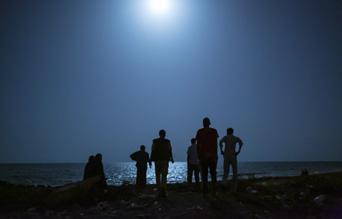





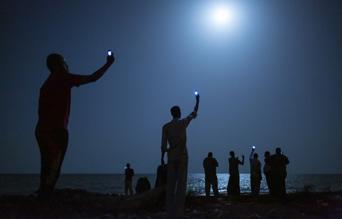
After a month of traveling overland from a small village in Ethiopia, I arrived in Djibouti City. On my second day in the capital, did what often do when in a place I’ve never been before — meandered in the natural process of getting lost.
Walking along the beach with my friend and translator, Stanislas, we came upon a group of people at dusk, all standing at different spots along the shoreline holding up their phones, some talking

In this tenuous period of human migration that never abates, where despair and hope intertwine, we seek comfort, a sense of balance, a desire to be home and reconnect to something stable and reassuring.
This photograph of migrants “catching” a signal is an image of all of us as we stand at the crossroads of humanity, where we must ask ourselves what is truly important, demanding our collective attention in a global society where the issues of migration, borders, war, poverty, technology, and communication intersect.

Who we are, our 8.1 billion who are in collective need of building bridges of hope, peace, and understanding for all of us in the only place we can live.
Earth.
John Stanmeyer, 2023
© JOHN STANMEYER
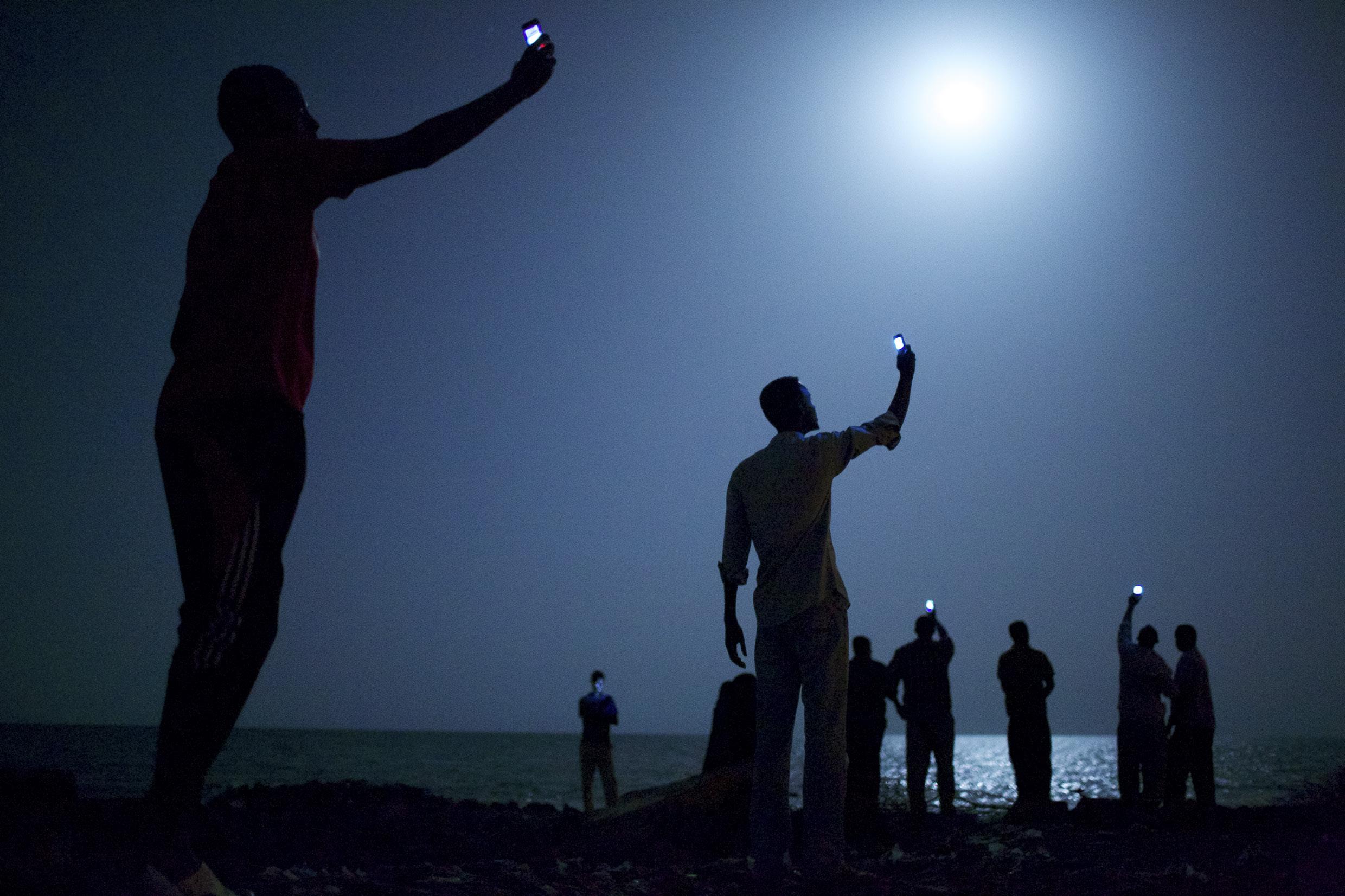 African migrants crowd the night shore of Djibouti City, trying to capture service from inexpensive cellular networks — a tenuous link to relatives abroad — from neighboring Somalia. For more than 60,000 years our species has been relying on such intimate social connections to spread across the Earth. Djibouti City, Djibouti, February 26, 2013.
African migrants crowd the night shore of Djibouti City, trying to capture service from inexpensive cellular networks — a tenuous link to relatives abroad — from neighboring Somalia. For more than 60,000 years our species has been relying on such intimate social connections to spread across the Earth. Djibouti City, Djibouti, February 26, 2013.
JOACHIM LADEFOGED MITROVICA, KOSOVO

Joachim Ladefoged (b. 1970, Denmark) is one of the most inventive and creative photographers at VII, revered by his colleagues. Ladefoged photographs everything with the same inventiveness and diligence, whether sports, war or commerce. His highly accomplished career has seen him master complex, violent news stories, commercial assignments, daily news, and rich, vibrant, and spectacular feature stories. Joachim is credited with being one of the driving forces behind the new wave of Danish photojournalism.



















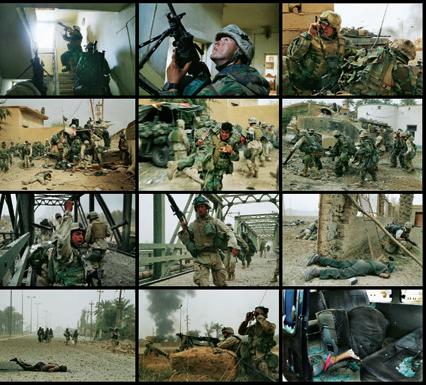

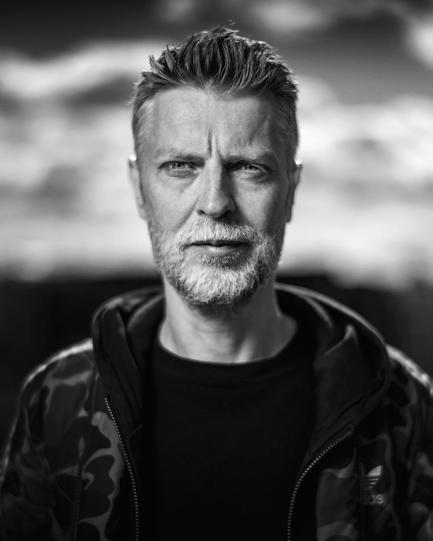
Just after the conflict in Kosovo in 1998-1999 when Serbian forces started an ethnic cleansing campaign, NATO aided the Kosovar Albanians by bombing Serbia to end the conflict by force. The Serbian soldiers left Kosovo to the Albanians. Mitrovica, the only large area that remained in Serbian hands, is divided by a river; on the south side live the Albanians, and on the north

side, you have the Serbs. The school lies on the riverside. In the schoolyard, some kids play basketball, while others are still in class having lessons.



Joachim Ladefoged, Mitrovica, 2000


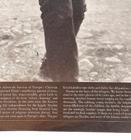































26 TELEGRAPH MAGAZINE Gary Knight (b1964) started working as photographer in south-east Asia during the 1980s as the region came grips with the end the Cold War. In 1993, he moved to the collapsing Yugoslavia, where he returned repeatedly to the siege of Sarajevo through the fall of Kosovo. After 9/11, he covered wars in the Middle East, Africa and Europe. Below The battle for the Diyala Highway Bridge, about nine miles south-east of Baghdad, was one of the first the major assaults of the Iraq War. The 3rd Battalion 4th Marines captured the bridge on April 2003, before pushing on into central Baghdad. Knight documented the run-up to the action and photographed the combat over three days Joachim Ladefoged (b1970) documented the history of the Albanians from 1997 to 2000. Nato’s bombing of Kosovo in 1999 caused an exodus of some 850,000 ethnic Albanians. On their return to Kosovo many sought revenge, killing Serbs who had had no connection with the war. Above 2000, young Albanians look out of window which reflected the Serbian part of Kosovska Mitrovica, city in Kosovo badly damaged during the 1999 war. Below Kosovo Albanian boy dives into lake outside Gnjilane, south-eastern Kosovo, June 1999 ‘We launched on September 8, then the world changed. And we’ve been following that story ever since’
Three days before 9/11, the photo agency VII (pronounced ‘Seven’) was born. That week, many members of the professional photography community descended on Perpignan, France, for the annual Visa pour l’Image festival, the international conclave for photojournalists. Many arrived with sense of malaise. Photojournalism seemed to be on the wane; celebrity coverage was ascendant. Many publications seemed to be sacrificing experience for expedience. Yet there was reason for hope. Seven leading photojournalists sat on stage at a ragtag press conference to announce the formation of small, independent photo collective part traditional agency, part global network reliant on the web to be based not in Paris or New York but at their seven separate computer desktops in their seven home offices, from Provence to Bali. ‘We were inventing [VII] as we went along,’ the agency’s initial strategist, Gary Knight, explains. ‘That week [in Perpignan] was the first time we had all met in the same room and had the opportunity to go through the business model together, face to face.’ Knight had felt something click while visiting the photographer John Stanmeyer in Hong Kong. ‘We were down in my studio,’ Stanmeyer recalls, ‘doing web stuff, talking about how to market an archive. And Gary said, “What about doing this together?”’ They joined forces with other photographer friends Ron Haviv, Antonin Kratochvil, Alexandra Boulat (1962–2007), James Nachtwey and Christopher Morris veterans of conflicts in Bosnia, Kosovo and the West Bank. ‘We launched on September 8, three days before the attacks,’ TELEGRAPH MAGAZINE 27 When a loose group of seven photojournalists decided to join forces, they were pessimistic for the future of their art. Days later 9/11 happened, and the role of their agency VII as witness to conflict and social injustice worldwide has been in sharp focus ever since. David Friend looks at their work, now collected in a new book BAPTISM
Nachtwey says. ‘Then the world changed. And we’ve been following that story ever since.’ The VII team would cover the subsequent war in Afghanistan. They would do the same in Iraq. The agency’s ranks have grown in recent years. now consists of Marcus Bleasdale, Haviv, Ed Kashi, Knight, Kratochvil, Joachim Ladefoged, Morris, Franco Pagetti, Stephanie Sinclair and Stanmeyer (Nachtwey has since dissociated himself from VII). Born in fire, it continues to cover places where the body politic is inflamed and to cover social issues in dire need of witness. Members envision their role as being documentarians of conflicts both large and small social, political, environmental – striving to produce what its founders call ‘an unflinching record of injustices created and experienced by people caught up in the events’. © CASPER DALHOFF
OF FIRE
 Albanian school children look out of a window reflecting the Serbian side of Mitrovica, a divided city in the north of Kosovo and one of the remaining parts of Kosovo that still has Serbians living there. Mitrovica, Kosovo, 2000.
Albanian school children look out of a window reflecting the Serbian side of Mitrovica, a divided city in the north of Kosovo and one of the remaining parts of Kosovo that still has Serbians living there. Mitrovica, Kosovo, 2000.
JOCELYN BAIN HOGG THE FIRM





Jocelyn Bain Hogg (b. 1962, UK) is an urbane, dignified and elegant thinker who takes visual risks and defies categorization in a country that likes to categorize. He has six monographs to his name. Embedded with gangsters and villains, he produced arguably the most intimate and revealing portraits of a criminal gang ever. Bain Hogg’s documentary projects on British gangsters are part of the canon of photography and are published in two volumes, The Firm and The Family.


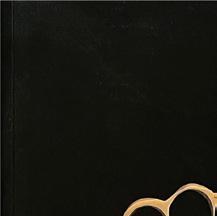
Having forsworn fashion and gone headlong back into making personal documentary work on my own terms, became immersed in the British criminal underworld following an assignment photographing a writer and two larger-than-life London gangsters, one of whom was “Brown Bread” Fred Foreman. Fred and I had bonded over scotch and conversations about fathers and sons during a nightlong Soho sojourn (Fred’s son Jamie is an actor, and my aristocratic birth father, Tom, had hoofed his way across the West End Stage, singing bass in musical comedies after his family fortune was blown).


That morning, I called a journalist friend in Tokyo, Tatsuya “Tats” Mizuno, who, undaunted by my excited and slurred voice, loved the idea of working on a story about the real Lock, Stock and Two Smoking Barrels world. Sure enough, Japanese GQ took his pitch, and Tats came to London several weeks later. remember the shock and surprise from the massed ranks of large men that Fred and his “associate” Dave Courtney introduced us to on our first outing to a packed pub in London’s




East End: the incredibly stylish Tats with his velvet jacket and goatee and me, suited and booted with a discreet Leica round my neck. Sore thumbs had nothing on the two of us. We hung back with nervous smiles, many cigarettes, and occasional gentle questions as the bar’s villainous clientele exclaimed that there was a “posh bloke and a f---ing Yakuza” in their midst. Thankfully, the highly respected Fred had spoken for us. Three weeks later, we completed our feature. Tats went home, but always intending that this had to be more than just another magazine piece, continued photographing this extraordinary hidden society. This image is from my first solo jaunt, where Dave Courtney, who had just published an autobiography to much fanfare, had been invited to the prestigious Oxford Union to discuss his life of crime. This photograph had another claim to fame when Jay-Z, without so much as a by-your-leave, and inserting himself on a look-alike desk, lovingly re-created the shot for the cover of his 2001 album, The Blueprint Ah, well.
Jocelyn Bain Hogg


©
SEAMUS MURPHY
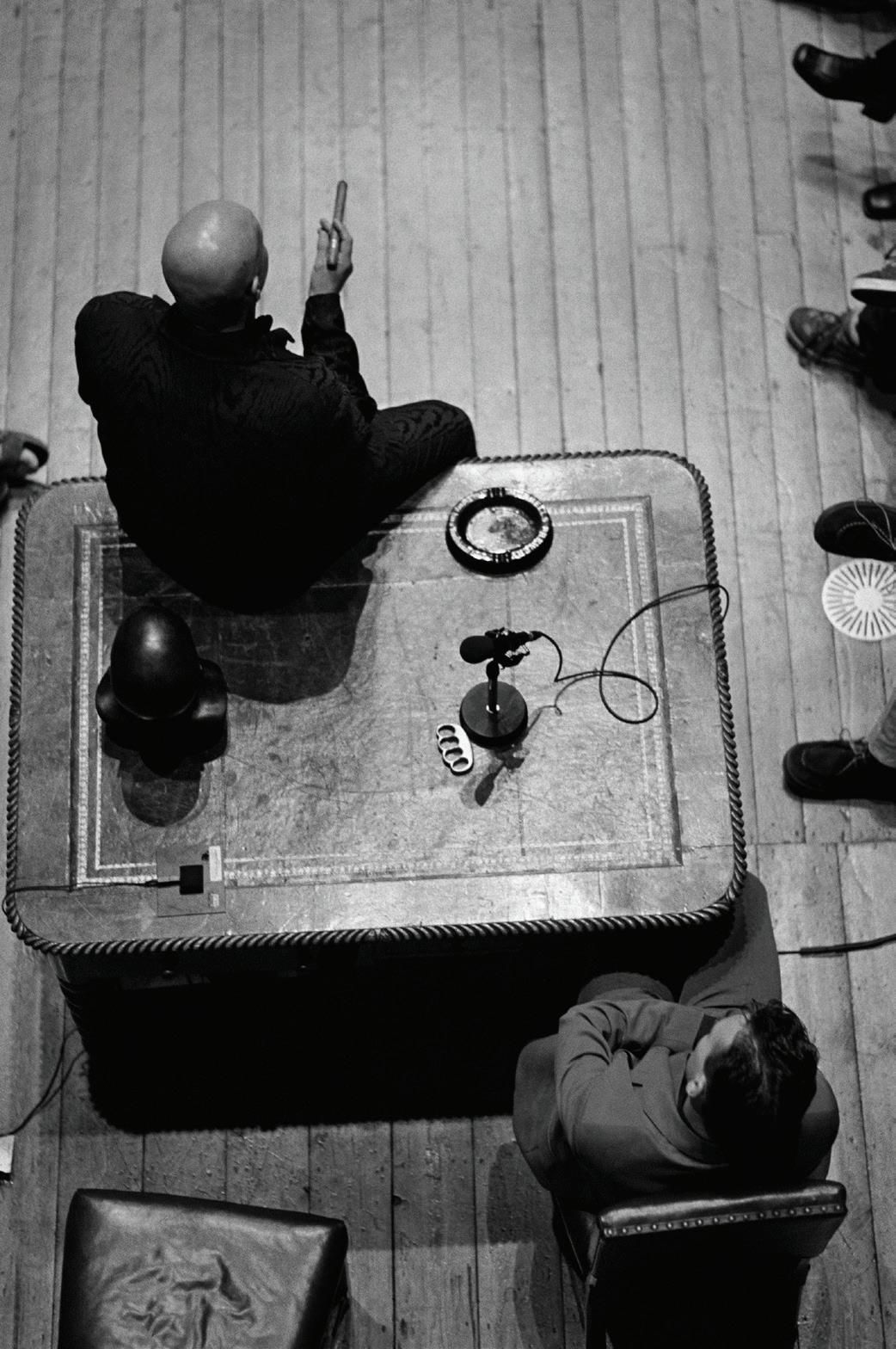



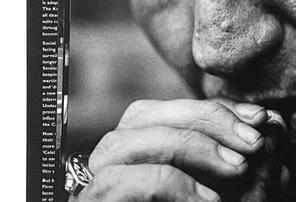





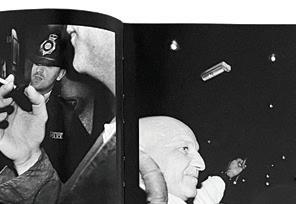
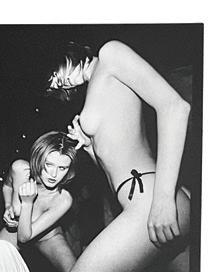




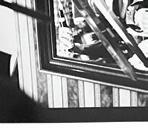



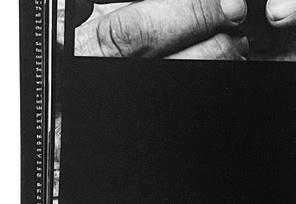



 The trademark knuckle-duster; Dave Courtney discusses his life of crime at the Oxford Union. Oxford, United Kingdom, October 1999.
The trademark knuckle-duster; Dave Courtney discusses his life of crime at the Oxford Union. Oxford, United Kingdom, October 1999.
LINDA BOURNANE ENGELBERTH
DIARY FROM ALGERIA


Linda Bournane Engelberth (1977, Norway) is an artist who was raised in Norway by her Norwegian mother. Growing up she never knew her Algerian father and his family. Curious about the other half of her family, she finally contacted her father as a teenager, and as an adult she became acquainted with her extended family in Algeria. When her Berber grandmother turned 100 years old, she wrote Linda a letter so that she wouldn’t forget about her father’s homeland. This project is an attempt to research her own identity as a Western woman investigating this foreignness that makes up half her bloodline.
As I lie awake in the night, the intense warmth keeps me away from much-needed sleep. My nightgown sticks to my body; my breath is slow. run a hand along the wall and its deep crevices. All that should be familiar is unknown. I try to imagine my grandmother running her hands against these walls, these details she knew so well. Perhaps she made these markings herself, one day when she was young and in love and pushed the bed against the doorway so that no one could enter. am trying to live another woman’s life, smell the scents she smelled, imagine that the etchings in the wall represent my own life lived. But they are not. No matter how much I pretend that this is my life, this is my life, this is my life...it is not.
Linda Bournane Engelberth, diary entry from Algeria, 2018








 © JAN CHRISTENSEN
© JAN CHRISTENSEN
 The view from the artist’s family’s window in Algiers is juxtaposed with an old photograph of her grandmother, Aisha. It accompanies a personal letter written by her grandmother to her granddaughter a few months before her passing. Algiers, Algeria, 2005.
The view from the artist’s family’s window in Algiers is juxtaposed with an old photograph of her grandmother, Aisha. It accompanies a personal letter written by her grandmother to her granddaughter a few months before her passing. Algiers, Algeria, 2005.
MACIEK NABRDALIK LESBOS





Maciek Nabrdalik (b. 1980, Poland) was pulled into the VII orbit as a very young photographer and became the youngest member of VII Photo Agency. From his base in Warsaw, his primary focus is on sociological, political, and cultural changes in Eastern Europe.


















Nabrdalik works in the humanist tradition and is highly regarded by his peers for his consummate skill and creativity, whether working in short films, long documentaries, photojournalism, or multi-year book projects. He is an adjunct professor and educator.












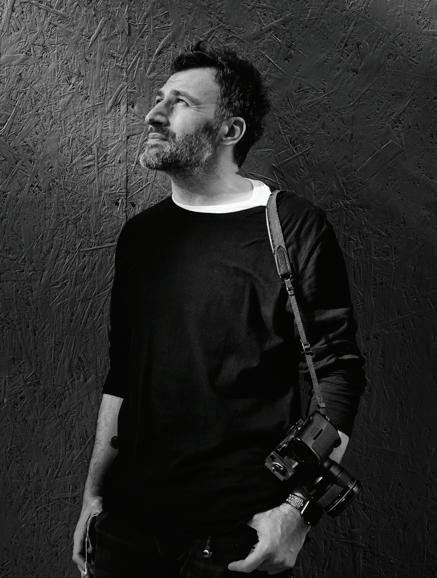
In Lesbos, Greece, I photographed this refugee family just after they left the pontoon in which they, squeezed with dozens of other people, had crossed a fragment of the Aegean Sea between Turkey and Greece. At that time, it was difficult to obtain basic information from refugees; most of them willingly allowed themselves to be photographed but did not want to introduce themselves. Often, after going ashore, they tore up their passports, fearing that their true identities might harm them. saw this family a day later near the port. wanted to
















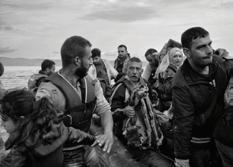

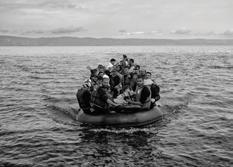


reconnect with them, but they were out of sight by the time I could park. Their image has haunted me ever since. I wonder how their lives turned out; they looked strong, somehow proud, and a journalist friend and wondered how we could find them without endangering them. We didn’t want to do it through social media because maybe where they were going, not everyone would know their past.



Maciek Nabrdalik, May 2023







































©
WOJCIECH GRZEDZINSKI
 Refugees from Syria rest on the coast of the Greek island of Lesbos. Thousands of refugees cross the Aegean Sea from Turkey in rubber boats every day, fleeing conflict in Syria, Iraq, and Afghanistan. Lesbos, Greece, September 24, 2015.
Refugees from Syria rest on the coast of the Greek island of Lesbos. Thousands of refugees cross the Aegean Sea from Turkey in rubber boats every day, fleeing conflict in Syria, Iraq, and Afghanistan. Lesbos, Greece, September 24, 2015.
MAGGIE STEBER ON HAITI
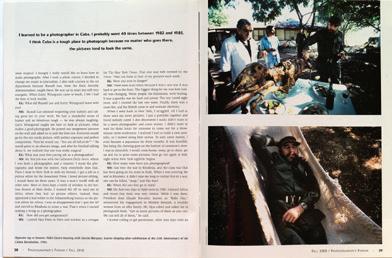

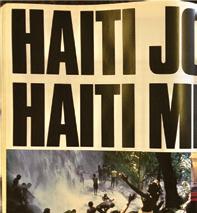



When one is in Haiti, one walks in a dream. Time is telescoped and one jumps erratically from one scenario to another without any links to join them and no interpreter to explain them. Sometimes the dream is one of excruciating beauty and sometimes it is terrifying.
Haiti is like an ache in the bones, bittersweet and seductive, addictive. People go there and either hate it, being repelled by the immense poverty and daily violence of living, or fall in love with it. I’ve always thought it was Haiti that did the choosing. Whomever it wanted on its shores was welcome. If it didn’t like you or need you, it did everything in its power to repel you, to send you flying. But if it saw in you a kindred spirit, capable of empathy and dramatic hyperbole, it allowed you to remain. It captured your heart, breaking it daily with its melange of beauty and suffering, and its narcotic of political dueling and the spirit world’s mysterious magic.
from magazines who are only interested in it when it’s exploding. But Haiti wrings everything out of you including your money. And money is nothing in comparison to what you realize from it. It can be very one-sided. So it’s important to keep the balance there.



Maggie Steber (b. 1949, USA) is one of the most important and pioneering American photographers of the 20th century and a legendary Director of Photography. Steber worked over a 30-year period in Haiti, an experience which led to the book Dancing on Fire: Photographs from Haiti. Internationally celebrated HaitianAmerican artist Edouard Duval Carrie wrote of her photographs: “Steber photographed Haiti’s rather convoluted modern history but always from the point of view of the Haitian people. Her photographs convey the grave dignity that is an innate character of Haitians, a core assumption of hers despite the numerous instances where her life had been threatened in the course of her assignments.

One must be very careful not to romanticize Haiti, neither its poverty nor the exotic lust and violent adventure early writers from the 20s and 30s described in travel books. It is a real place with real people, the majority of whose lives are engaged in a daily struggle of survival to eat, to work, to live. Haiti is the daughter of Africa and France. It grew up in isolation because it was too strong, too independent, too strange. This land and people have been so violated by so many who had a hand in its formation. Its lands are haunted, drenched in the blood of great heroes and small children. It is as though the fates pointed one day to Haiti and declared, “There shall we put the portal between Heaven and Hell!” Everything fits neatly into that concept of extremes.
Two things are certain. The first is that Haiti is a place filled with lessons. It chooses you because there is something you need to learn. It is a living parable, a Shakespearean epic in which you are supposed to participate. And the experience changes your life forever.
The second thing is that whatever you think you know about Haiti amounts to nothing. Actually, anyone who is not Haitian can never really know Haiti, or completely understand it. Non-Haitians like me stand with our noses pressed up against the glass window, able to look inside but unable to enter, no matter how much we fool ourselves to the contrary. No matter how great our desire. At best we can offer ourselves up as a conduit which gives voice to a people whose cries compose a song of survival.
When it comes to using Haitians by way of photographing them, here’s how I address that issue. I have to do this or else am no better than the worst exploiter. When realized that would continue to work in Haiti, made a pledge that 50% of all monies made with my Haitian photography would return to Haiti. Not to charities. Directly to people. And if couldn’t find the people had photographed to give the money to, I put children through school with it and helped a woman with five children build a house. helped send a young woman political activist to law school. And when took pictures, I gave people money even though my colleagues would chastise me if they knew because then Haitians wouldn’t allow them to take pictures unless they paid. And many times, I used the money for people I never photographed, like a legless beggar for whom bought a used wheelchair or a man for whom bought a car to use as a taxi to feed his family. am not wealthy at all. And it’s very expensive to work in Haiti, especially when a photographer does so without financial compensation
And if people don’t want to be photographed, I don’t take their photo. It is important to note, however, that often, very often, Haitians have asked me to take their picture. They wanted to be photographed and if I could, would take a copy of the photograph back to them. On several occasions, took hundreds of Polaroid photos of Aristide’s orphaned street boys who, in their delight, fought over the photos and shredded them to pieces at a $1 per sheet of film. And I took color prints back to the small village of Duverger where I spent a week and took formal portraits of every single person in the area. When I returned with the prints, people were so delighted they killed a pig in celebration, a precious pig. I have buried people’s mothers and paid for the doctor and medicines for their children. I have paid rent on houses and carried big suitcases of clothes and shoes into the countryside and stopped along the road where a farmer was planting and invited him and his family and anyone else I could find to come to the car and take what they needed. Are these things acts of charity? No. They are payback. They are payback for allowing me to see the beautiful young girl in a tattered blue lace dress dancing in the dirt of Rabato. They are payback for letting me help deliver the baby of a woman in the dirty doctorless Gonaives hospital. They are payback for watching as the mysteres danced around the heads of hounsis at Vodou ceremonies.
Haiti, almost as much as my mother, gave life to me. I can never repay the Haitian people. But I will try to as long as I breathe. I normally don’t share all this information with people for fear of making myself sound righteous and self-important. But I do believe that we all have to stand for something.


One last thing: sometimes when photographers point their cameras, it is to capture the courage and spirit of a people. While that doesn’t help fill the stomachs of starving people, the most important thing that photography does is to document history. And photographs are evidence that someone lived…and died…and the photographs are an attempt, in some few cases, of ensuring that a life meant something.
None of the above excuses exploitation. That will go on long after we are gone. What I would like to do is to be collaborative with the Haitian people in telling their story. They wear me out because it needs so much telling. If no one ever took the picture, who would know of the violence sent against them, of the injustice, of the hunger and poverty, of the beauty and the courage and the indomitable spirit of these children of history? People would only have words to read. Words, too, can be exploitive.
Just as there are bad things written and good things written, there are good photographs that go beyond showing a person who is poor and show us someone who is rich in courage. A bad photograph can show someone who looks miserable in their suffering and is not taken in any way that draws us into that person’s whole experience. I cannot make excuses for photographers and what they do. I can only say that sometimes there are some who try to do something that is good.
Maggie Steber, On Haiti

At times life looks a lot like art in Haiti. Sometimes even tourists take good pictures there because the material is so easy to access. It also has qualities of literature that just happens to happen every day in Haiti. In the visual realm Port-auPrince’s jumble of pink and green and blue cement houses with their retaining walls and tin roofs and alleyways going off in all directions look elegant from any angle.
After your initial enthusiasm for the place and the people and the stories, after a year of saying incredible over and over, it slowly becomes apparent that the line between what you bring to your work and what the innate elements of the people who you meet and photograph bring to it is a thin and fading line.
You begin to feel too keenly your own irrelevance in your work. The means of rescue from this sometimes awkward artistic problem is simple: a bond forged with your subject brings you into the subject matter and then you can to some small degree see your own work from your subject’s point of view. You re-see Haiti and Haitians.
Because plain beauty in Haiti is not enough. To us (postcard viewers even at our most sophisticated), everything in Haiti is exotic and beautiful, more than we often see: the old toothless guy, a goat tied to a Mapou tree, hovels of people rising out of the mud near the market.

But this is not enough. We need a guide to tell is how it feels to be that man, what that tethered goat signifies, why people live in mud and what they think about it. Maggie Steber is that guide, a photographer who makes sense out of the senseless without diluting the mystery of Haiti’s beauty and heart.

Her work is generous and selfless and fiercely subjective. You get





the feeling that she is, literally, on the side of her subjects. She knows them. That’s the photographer you see looking out at you from the eyes of her subjects.
This is the best kind of artistic identification.



In Haiti Maggie spends her downtime getting exhausted. She is on the road in the heat in a rented bus, driving thirty noisy and impossible street boys to the beach for a day.
She is out in the courtyard taking Polaroids of the boys. She is in the rotting state hospital with one of the boys who was injured, scolding nurses who refuse to do anything to remedy the injuries. She is at the pharmacy buying bandages for the boys’ cuts. She is at the market, negotiating a wheelchair for a legless beggar. She is putting a young mother with AIDS in the hospital. She is always making connections, always full tilt in a dramatic relationship that involves her to the point of depletion. And that is the moment, of course, when she does her deepest, her best, and her most honorable work.
So much is visual and visible in Haiti that it is easy to forget the hidden sides of Haitian life. But they are there, in spite of thin walls and one-room shanties and slums so crowded that sometimes men have to sleep standing up. The hidden side is there, fully lived. The place where you can glimpse it is in their eyes, the eyes of the angry politicians, the eyes of the crippled child, the eye of the proud mother. Look into those eyes and a hidden Haiti will slowly emerge — the emotional, passionate, religious, devoted, comic brilliance of an entire nation.
Amy Wilentz, Introduction to Dancing on Fire (Aperture 1991)





Mother’s Funeral: A young Haitian man writhes in grief at the funeral of his mother in Haiti’s National Cemetery as his family and friends try to hold him back from the coffin. His mother was killed on election day when men with guns and machetes attacked a polling center during national elections in Haiti to choose the first elected president after the 30-year dictator, François Duvalier, fell. Hundreds of voters across the nation were attacked and killed, and polling stations across the county were burned. Streets in all the towns and cities emptied out as men in cars shot people on the street with machine guns. The elections were canceled. Port-au-Prince, Haiti, November 1987.

NICHOLE SOBECKI A CLIMATE FOR CONFLICT

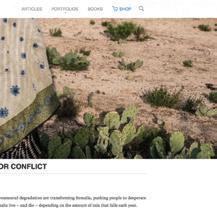











Nichole Sobecki (b. 1986, USA) has made East Africa her home and the primary focus of her work on humanity’s fraught, conflicted and inescapable relationship with the natural world. In 2016 she began working on the project, “Where Our Land Was,” from which this photograph is drawn, that investigated the human consequences of environmental change in Somalia. She is currently examining the vital role the Congo Basin plays in the Earth’s ecological balance.





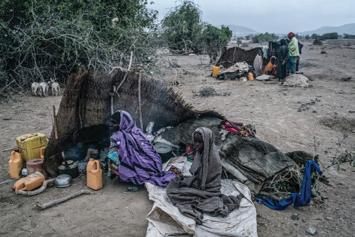



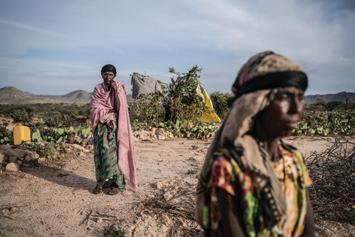


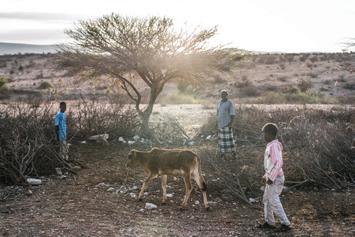



Somalia has never been a forgiving place. Now, decades of civil war and the effects of climate change have set the country on a path to environmental disaster. Temperatures are rising, and drought has become the norm. Despite the resilience of its people, Somalia may be the most vulnerable country in the world to climatic changes. Where Our Land Was tells the stories of people struggling to cope as their land is transformed beneath them: the farmer who went to war with neighbors over pasture and water, the nomadic elder struggling to adapt as his way of life dies off with his herds, the mother displaced from her land by drought and facing an uncertain new world.

This story has taken many forms over the years, from print features in National Geographic and Foreign Policy magazines, a short documentary film, a feature on ABC’s “Nightline” program, numerous podcasts and interviews, and global exhibitions. Most critically, it has helped to grow awareness around the overlooked ways in which conflict and climate change collide in an agonizing feedback loop that punishes some of the world’s most vulnerable people. It has been the center of dynamic programming, bringing together experts on the climate-security nexus from Washington, D.C., to Nairobi, Kenya, and was featured at the Nobel Peace Center’s first-ever Oslo



Pax, an annual gathering to forge a peacebuilding space the world urgently needs. This long-term project is a visual reminder that the climate crisis is not a distant myth. Already parts of our world are becoming uninhabitable, pushing communities to the brink. “Still, we are thinking human beings,” said Somali environmentalist Fatima Jibrell. “It’s not in our nature to give up. Nobody wants to die sitting down.”
Nichole Sobecki, June 2023

© LYNSEY ADDARIO
 After washing clothes in a roadside puddle, a woman walks home through a parched field in drought-stricken Somaliland. A changing, more extreme climate has upended millions of lives in the Horn of Africa. As cattle, goats, and camels have died off, seminomadic pastoralists like her have had no choice but to move, often to displacement camps or cities. Somaliland, April 6, 2016.
After washing clothes in a roadside puddle, a woman walks home through a parched field in drought-stricken Somaliland. A changing, more extreme climate has upended millions of lives in the Horn of Africa. As cattle, goats, and camels have died off, seminomadic pastoralists like her have had no choice but to move, often to displacement camps or cities. Somaliland, April 6, 2016.
PAUL LOWE A FAMINE IN SOMALIA


Paul Lowe (b. 1963, UK) is an academic and a photographer. A professor at London College of Communications, University of the Arts, London, Paul’s research explores the relationship between photography and conflict and the effect of photojournalism on public discourse. His research around the ethics of representations of suffering, especially concerning the concept of bearing witness to trauma and the photographic documentation of genocide and war crimes, is informed by his own powerful work photographing the wars in Bosnia, Chechnya and Rwanda in the 1990s.

Oall the tragedies reported in recent months, the catastrophe in Somalia has touched a particularly raw nerve, highlighting many dilemmas of working in news that are too often overlooked. It might be the scale of the disaster, with over 2,000 people dying every day (and Somalia is only one of many African states in a similar plight), or the helplessness of the photographers to offer immediate relief to the individuals before them, or the conflicts between the haves and have-nots. The shock of exposure to the horrors has left many photographers stunned.
There is an assumption that journalists must be a bit blasé about the enormous subjects that are reported on: we have seen it all before, and the job becomes a matter of professionalism and the efficient delivery of pictures to the client. In the process, the industry creates heroes as the perception of suffering is transferred from the subject to the courage of the photographer in struggling against the odds to make great pictures — careers are made in this way.
It is easy to be cynical in a situation where, like Somalia, a disaster has been building for over two years, and yet so little attention
has been paid until magically it hits the media’s news agenda. The process by which this continuing tragedy becomes newsworthy in September in a way that it was not in July is mysterious and endlessly frustrating (what about the rest of Africa?). But money and exposure become available for those photographers who choose to visit the scene and, sure enough, suddenly everyone is concerned. Such cynicism is a distraction: the reality of starvation and death exists in Somalia and the rich nations can offer help — there is a job to be done in reporting from Africa to the north and the role of photography is particularly powerful in conveying the physical and emotional horrors. There is a strong feeling among some photographers returning from Somalia (and other concentrations of appalling suffering) that this is a time to abandon the conventional measures of professionalism: forget about the construction of clever pictures or the theories of representation, just concentrate on what is happening.
As Roger Hutchings put it: “Don’t bullshit or get clever — it’s a catastrophe, you must photograph it straight (though eloquently) to see the truth and show it.” Chris Boot, editing Chris Steele-Perkins’ work for Magnum, pointed out that “at the core of his work was an abandoning of art and artifice — though he was working in a very commercial way, demanding that the pictures should be seen and used. It was a purer exercise in communication.”
Here the contradictions begin: the pictures from Somalia are in direct competition for editorial space with other material and need to fight on equal terms. Again, Steele Perkins demonstrates the case, as The Independent Magazine had rejected Somalia as a feature story — until it saw his pictures, which forced a change of policy. However pure the intention, there is a need to make “better” pictures that will grab the pages.
Paul Lowe describes the photographer’s requirement for two antennae: one journalistic to keep in touch with what is happening (the content of the story to be told), the other being photographic for the mechanics of how to express what is experienced. It is a constant struggle to maintain a balance between the two, which is only partially resolved by expertise. Many of the photographic techniques are internalized, absorbing little conscious thought (“You know the sound of the camera,” says Mike Goldwater), but which still require some attention: issues of journalistic analysis and photographic composition need intellectual energy. “It was difficult to make pictures when I first arrived,” says Lowe. The scale was overwhelming, and it was almost too easy to make a shocking picture — but it was impossible to comprehend what it was about.”

The trick must be to not let the technical processes dominate. Looking and understanding are key elements of communication, but without feeling, the results, while technically “good,” will be
arid — emotion must also be allowed a space. “If you feel nothing, you reveal nothing,” comments Goldwater. There is a limit on how much anyone can open themselves to such incomprehensible suffering, and it can be a brutalizing experience within which every photographer must establish their own limits of effective operation. Lowe reports a strange sequence of involvement that took him from his shocked arrival in a strange culture through a curious balance of participation and immunity (“though I was surrounded by calamity, I was not personally threatened by famine”) to a hardened state where the boundaries between appropriate behavior and exploitation began to blur. This is a dangerous moment that photographers must identify if they are to avoid merely “stealing” pictures — many describe a temptation to “art-direct” reality to produce pictures that are visually powerful (and maybe commercially productive) but which diverge from honest reportage. Lowe chose this point to leave Somalia, but it is a summary reminder that, contrary to the received wisdom of concerned photography, it can be possible to spend too long in a situation. Faced by such ultimate horror, the photographer has an apparently straightforward job to accomplish, to be the eyes of the world and to bear accurate witness for the rest of humanity. But the judgments involved are delicate and convoluted. There is no single reality to report, and every level of involvement reveals different truths, each viewpoint offers different perspectives (literally and emotionally). It is the photojournalist’s job to be informed about what to look for, but alert and open to the unexpected.
Looking at the finished results, all the conventional forms of evaluation seem inadequate. The usual terms of assessment are about the picture, not the situation depicted: “a good photograph,” “a strong image,” “a powerful representation,” and (along with many colleagues) have even caught myself grotesquely referring to “a nice picture.” The emotions that the editing process produce are conflicting, especially when on the phone selling the product, and the suffering of others becomes a negotiation about filling commercial space and assessment of cash value. Feelings of pain, pity, and guilt mix with professional satisfaction.
Perhaps where pictures have such a gritty function the evaluation should also be more pragmatic, and we should think in terms of “effective” photography. But the production of pictures is only part of a larger process controlled ultimately by the publishers and the readers who choose to engage or to look away. It is the job of the photographer to lead the production process, by allowing the rest of us the opportunity of a greater understanding of what they have seen.
Stephen Mayes, “Just doing a job?”, British Journal of Photography, September 24, 1992

© JUSTIN MCKIE

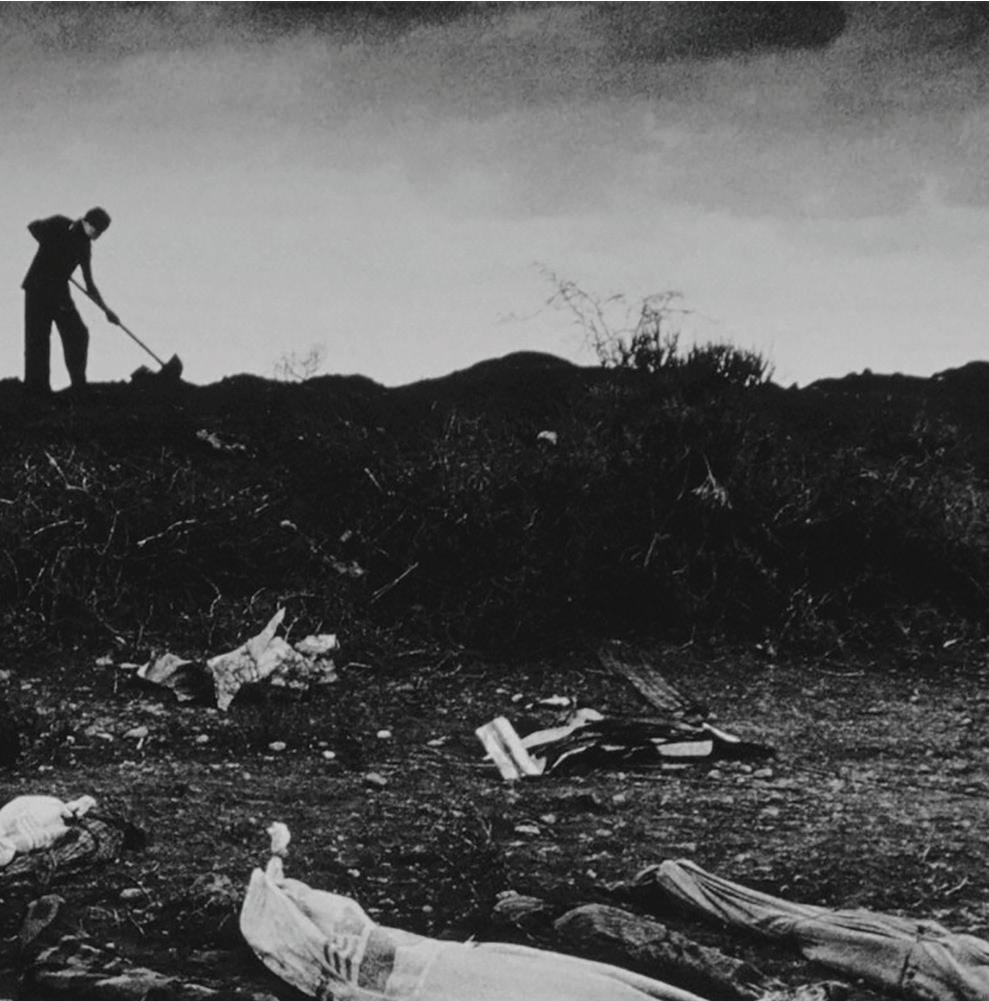


 Somali aid workers take it in turn to dig graves at one of the cemeteries. At the time several hundred people died here every day. Because of looting by heavily armed gangs, the distribution of aid approved by the U.N. in July could not be adequately policed. This situation did not significantly improve until Operation Restore Hope got underway at the end of 1992. Baidoa, Somalia, August 1, 1992.
Somali aid workers take it in turn to dig graves at one of the cemeteries. At the time several hundred people died here every day. Because of looting by heavily armed gangs, the distribution of aid approved by the U.N. in July could not be adequately policed. This situation did not significantly improve until Operation Restore Hope got underway at the end of 1992. Baidoa, Somalia, August 1, 1992.
PHILIP BLENKINSOP HMONG IN LAOS

Philip Blenkinsop (b. 1965, UK) moved to SE Asia in 1989 where he lived for almost three decades, immersing himself like few others in the lives of some of the region’s most vulnerable and isolated communities. In January of 2003, Philip trekked through the mountainous rainforest of northern Laos — one of the most impenetrable and inhospitable environments known to man. He was searching for Hmong veterans of the CIA’s Secret War and their families who were being systematically hunted down. They were long-forgotten members of a hill tribe who fought for the Americans during the Vietnam War and who were abandoned when the American forces withdrew. When he encountered them, his was the first white face any of them had seen since the end of the war.


Blenkinsop has been called “a man of guerrillas and of resistances” (Hervé Le Goff) and “one of the most essential photographers of his generation” (Christian Caujolle). His uncompromising vision and commitment to the region have given birth to a contemporary body of work that is at once remarkable and unparalleled.




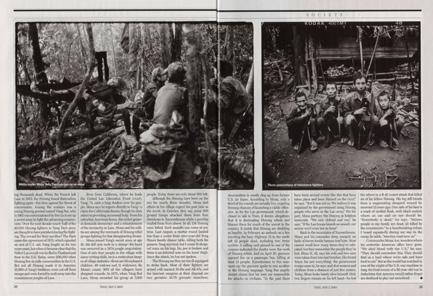







 © PHILIP BLENKINSOP
© PHILIP BLENKINSOP
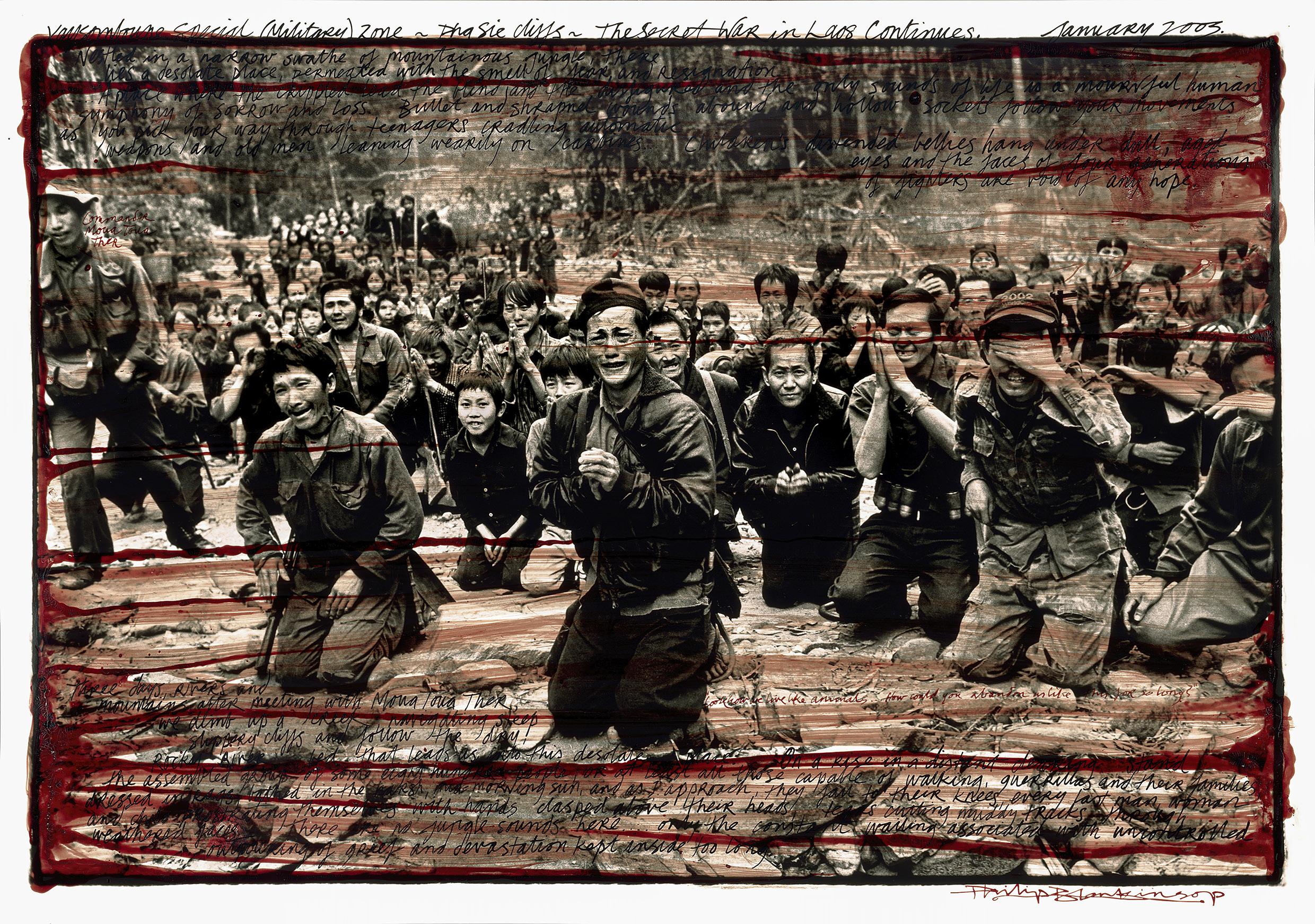 Believing that we are Americans returning to lead them all to safety, Hmong veterans of the CIA’s Secret War in Laos and their families fall to their knees crying as my colleague and I approach their secret camp. The group of some 840 people is one of several that has been targeted by Lao Government troops continuously since the end of the Vietnam War. Pha Sie Cliffs, Xaysomboune Military Zone, Laos, January 2003.
Believing that we are Americans returning to lead them all to safety, Hmong veterans of the CIA’s Secret War in Laos and their families fall to their knees crying as my colleague and I approach their secret camp. The group of some 840 people is one of several that has been targeted by Lao Government troops continuously since the end of the Vietnam War. Pha Sie Cliffs, Xaysomboune Military Zone, Laos, January 2003.
RON HAVIV WAR CRIMES IN BOSNIA AND HERZEGOVINA





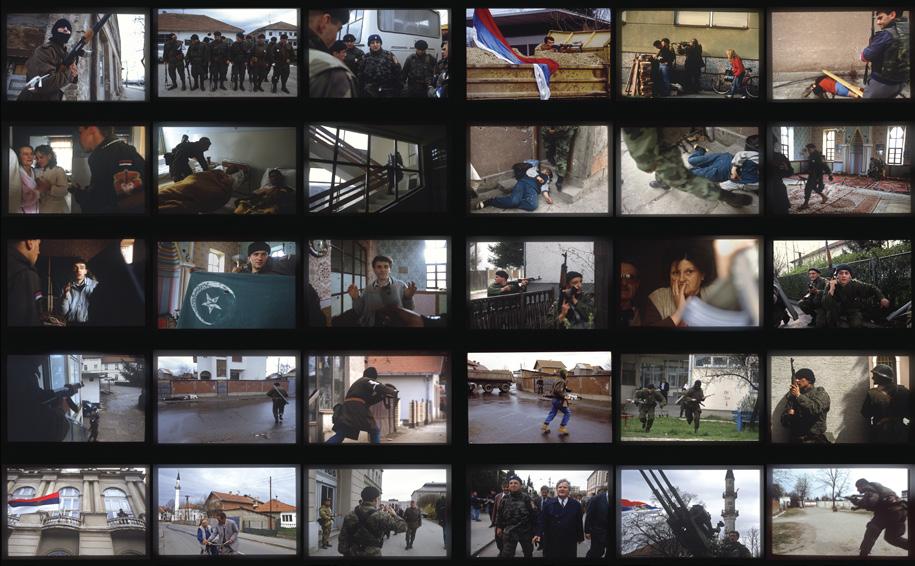
Ron Haviv was the first photographer to document ethnic cleansing happening in front of his eyes in Bosnia. At immense personal risk, he followed the infamous Serb paramilitary unit “Arkan’s Tigers” in the early days of the war. Haviv has a long and distinguished career, during which he has photographed war, politics, social upheaval and natural disasters. His career started in earnest, covering the violent presidential elections in Panama in 1989 and continues today. His most recent work has been documenting the war in Ukraine.

Haviv is a Director and co-founder of The VII Foundation and VII Photo. He takes photographs, directs films, makes books, and helms projects like Lost Rolls America, a national archive of images from the public’s forgotten rolls of film that invites participants to remember and review a piece of their — at times, forgotten — past. He is currently co-directing the film Biography of a Photo, looking at the impact this photograph has had in the more than 30 years since its creation.
Ron Haviv’s photograph was used in ICTY Case No. IT-03-69-T against JOVICA STANIŠIĆ and FRANKO SIMATOVIĆ for their involvement in war crimes in BosniaHerzegovina. Defense witness DIMITRIJEVIĆ, a former SDG (Serb Voluntary Guard) member, identified fellow member GOLUBOVIĆ (DB) in a photograph by Ron Haviv depicting him kicking civilians on the ground just after the Bijeljina takeover. THE APPEALS CHAMBER dismissed STANIŠIĆ’S AND SIMATOVIĆ’S APPEALS, reversed ACQUITTALS FOR JOINT CRIMINAL ENTERPRISE LIABILITY, AND increased their SENTENCES TO 15 YEARS’ IMPRISONMENT.

1992, Bosnia and Herzegovina: Tensions were high as the possibility of independence or war existed; no one knew what would happen. There were reports of fighting between Bosnian Serbs and Bosniaks in the town of Bijeljina, Bosnia, on the border with Serbia. I photographed the civilian population as they turned on each other, banker against bookkeeper, teacher against policeman, divided along ethnic lines. After several days of fighting, a convoy arrived with the Serbian paramilitary unit known as the Tigers. Their leader, Arkan, exclaimed, “I am here to liberate the town of Muslim fundamentalists.” He remembered my taking a photograph of him holding up a baby tiger, which he liked from the war in Croatia..
I was permitted to photograph his men as they searched for Muslim fighters. Having found none, we reached the center of town at a mosque. The soldiers entered, replaced the Islamic flag with the Serbian one, and took a young man, Harush Ziberi, no older than I at the time (25), a prisoner.
my car. Then Arkan arrived and said: “Look, need your film.” In the end, I had to give him the film that was still in the camera while saving the hidden film.
That night, was very emotional about what I had witnessed and how these people had died. But at least knew I was able to document it. I truly believed that my images were evidence of what would come unless the world acted quickly. thought they could have a chance along with everything else being discussed in preventing the Bosnian war.
While the images were published worldwide and caused a bit of an uproar, it was not as much as I had hoped. There was no real reaction, and the war officially started a few days later, leading to thousands killed, millions of refugees, and a country that cannot leave the past behind.
Over the following 30 years, the image has taken a life of its own, impacting both individuals and the population. At the opening of the International Criminal Tribunal for the Former Yugoslavia (ICTY), a speaker referenced the image as one of the inspirations for the court’s creation.
IRMCT Chief
Brammertz gave the following statement:
The final convictions of Jovica Stanišić and Franko Simatović today continue the justice process for the atrocity crimes committed during the conflicts in the former Yugoslavia. Independent international judges have now confirmed on final appeal that as senior officials in the State Security Service of the Republic of Serbia, Stanišić and Simatović are guilty as participants in a joint criminal enterprise to ethnically cleanse non-Serbs from Serbclaimed territories in Bosnia and Herzegovina and Croatia. Other participants in that joint criminal enterprise include Slobodan Milošević, Milan Martić, Milan Babić, Goran Hadžić, Radovan Karadžić, Ratko Mladić, Momčilo Krajišnik, Biljana Plavšić, and Željko Ražnatović (aka Arkan).
This appeal judgment forms part of the record of the suffering of the people of Bosnia and Herzegovina and Croatia between 1991 and 1995. Hundreds of thousands of victims were forced from their homes. Tens of thousands were tortured, abused, raped and killed. These were campaigns of crimes designed and implemented by political, military and police leaders in Bosnia and Herzegovina, Croatia and Serbia who decided to use atrocities to cleanse territories of innocent civilians from different ethnic and religious groups. Those essential facts have been proven yet again in this case, as they have in so many judgments by the ICTY and IRMCT.
That record, though, also demonstrates that the international community, when united, can deliver justice to the victims and hold the most senior perpetrators responsible for their crimes. 31 May 2023

I heard some shouting and walked outside, seeing that across the street, a middle-aged married couple, Abduraham and Hamijeta Pajaziti, were brought out. The soldiers were telling me not to take any photographs when some shots rang out suddenly, and the man went down. His wife crouched, holding his hand and trying to stop the blood. Then Ajša (Tifa) Šabanović was brought out: more gunfire rang out, and both women were shot.
As I stood there, shocked, my presence with a camera had done nothing to stop the killing, and there was nothing I could have done; had just witnessed a war crime that the world needed to see. I thought the images of them being shot alone would not be enough, I needed the soldiers in the same frame as the victims.
Then, just as I was about to take a photograph, one of the soldiers, a brash young guy in sunglasses, smoking a cigarette, brought his foot back towards the bodies as they lay dead or dying.
I wanted to leave town before Arkan found out what happened, but couldn’t leave without his permission, so I hid some film in
The image was used for indictments and in several war crime trials at the ICTY. The photograph has crossed from journalism to artwork, culture, politics, education, and propaganda and is the subject of several films and numerous academic studies. Arkan put me on a death list, claiming “he looked forward to the day he could drink my blood,” and spent the remainder of the breakup of Yugoslavia avoiding him until he was assassinated.
Alma Pecković, daughter of Ajša Šabanović, has brought the photograph to the Serbian War Crimes Tribunal in the hope of justice by indicting the three men for the war crime of killing her mother, based solely on the evidence provided in the image. The main soldier in the photograph is said to be a famous DJ in Belgrade, sparking outrage on why he has not been indicted.
Ron Haviv, June 2023
© ADRIAN WHIPP
Prosecutor Serge
 Members of Arkan’s Serbian paramilitary group, the Tigers, with executed unarmed Muslim civilians Abduraham (L), Hamijeta Pajaziti (R), and Ajša (Tifa) Šabanović (C) during the first battle of the Bosnian war. Bijeljina, Bosnia, April 2, 1992.
Members of Arkan’s Serbian paramilitary group, the Tigers, with executed unarmed Muslim civilians Abduraham (L), Hamijeta Pajaziti (R), and Ajša (Tifa) Šabanović (C) during the first battle of the Bosnian war. Bijeljina, Bosnia, April 2, 1992.
SARA TERRY AFTERMATH
Sara Terry (b. 1955, USA) went to the Balkans in 2000 to work on a long project examining post-conflict Bosnia. Like many journalists who have spent time there, it changed her forever. As a consequence of her 2006 book Aftermath: Bosnia’s Long Road to Peace, she founded The Aftermath Project, a grant-making educational nonprofit that explores post-conflict issues through photography, and seeks to engage the public in conversation about the true cost of war and the real price of peace, and to change the way the media covers conflict. The Aftermath Project has supported photographers working on vital post-conflict stories for 16 years.
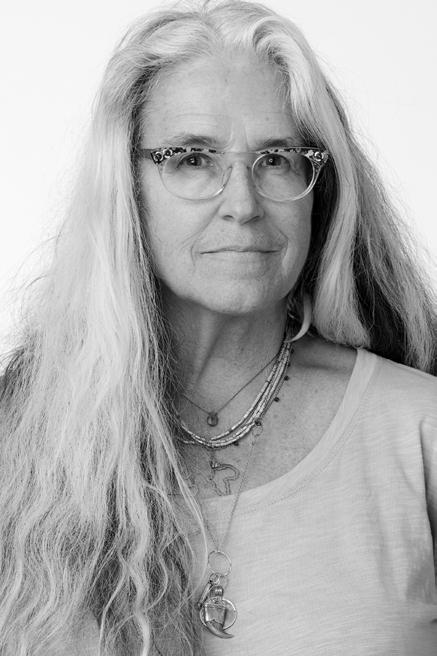
Ishould say, from the beginning, that never flew into Sarajevo on a military cargo plane, listening anxiously for the sound of artillery fire. never saw anyone killed in the infamous Sniper Alley that was a death trap during the three-and-a-half-year siege of Sarajevo by Serb forces. never had a gun pointed in my face, I never feared for my life, never interviewed a man who would die the next day, a woman who had been gang-raped, a parent who had just buried a child, or a family who had fled the blood-soaked soil of a village burned to the ground in the name of “ethnic cleansing.”
No, for me, the 1992-1995 war in Bosnia and Herzegovina was something that happened far off, in a place I’d never been. It was something struggled to understand, or ignored when the news was too depressing, from my home in Boston, where wrote of other things. I did not come to Bosnia until the fall of 2000, in the midst of changes in my own life. I found myself drawn at last by a newspaper article that said that just as Bosnians were finally feeling secure enough to start returning in large numbers to homes they had fled during the war, the international community was becoming “fatigued” with the Balkans tragedy and was starting to move its aid and attention elsewhere. The result was that few Bosnians would receive help in what seemed to me to be a Herculean task of returning to homes haunted by tragedy and lingering hostilities. was dismayed by the quick-fix shortsightedness of it all, concerned that the West was turning its back on Bosnia once again, just as it had during a war that was marked by the worst genocide in Europe since the end of World War II.
I felt compelled to go, to do whatever I could as a journalist to be a witness to the country’s ongoing struggle to rebuild a civil society. Although I began my career as a print journalist, working first for The Christian Science Monitor as a staff writer and later as a freelancer for The New York Times, Rolling Stone, Fast Company and others, by the year 2000 I was well into a career transition into photography and had been ready for some time to take on a long-term documentary project.
So went to Bosnia to cover the aftermath of war — to try to capture the images that are the all-too-often forgotten companions of the vivid pictures of war itself. I came with the conviction that war is only half the story. I believed, and still believe, that what happens in the aftermath of war is as newsworthy, if not more so, than the destruction and horror of war. I went to Bosnia with a desire to document that incredibly difficult period when humans move out of war’s desperate struggle to survive, and begin another equally mighty struggle – that of learning to live again. In the four years spent making the images that would ultimately become this book, became convinced that we need post-conflict images to remind us of our humanity – to testify that war is not the final word on who we are as human beings, nor the final image of our spirit.

My experience of Bosnia has been marked not by war, but by the echoes of war, by the scars it has left behind. My work and travels have been charged with the struggle of rebirth, not the horror of destruction. have spent long hours with widows of Srebrenica — the Muslim women who lost some 7,000 to 8,000 men and boys
in a 1995 massacre by Serb forces. have been with them as they returned to visit homes they fled in terror, have been with them when they have laughed, cried and prayed for their dead.
I spent a rainy afternoon with a man as he exhumed a shallow grave containing his father, killed eight years earlier by Serb neighbors. I have spent days in a warehouse lined with body bags, filled with the remains of recently-exhumed victims of the Serbs’ 1992 ethnic cleansing campaign — while family members, mostly women, walked the aisles of skeletons, sobbing quietly, looking for loved ones; as one woman picked up skull after skull with her bare hands, searching for signs of a son.
I have stood on the freshly laid concrete floors of homes being rebuilt by returning refugees, determined to reclaim their land and their lives. was in the crush of a group of young people, crowded in the square outside the National Theatre in Sarajevo, cheering wildly as they greeted Danis Tanovic, fresh from his Oscar victory for his film about the war, “No Man’s Land” — a victory he
celebrated in his homeland on April 5, 2002, just one day short of the tenth anniversary of the beginning of the siege of Sarajevo.
I have spent afternoons in Sarajevo with the 3K Sarajevo wheelchair basketball team, made up of young men who were wounded by snipers as civilians or while serving on the frontline as soldiers. have watched them sweat and spin on a dime and flirt with girls when practice is over, and I have come away determined that the world’s final image of them be their strength and grace — and not the moment when they lay sprawled on a city sidewalk, another tragic victim of war, another image of despair. I want to tell the story of their aftermath. want to tell it all.

The end of war does not mean peace. It is simply the end of war, the end of death and destruction. Every story of war includes a chapter that almost always goes untold — the story of the aftermath, which day by day becomes the prologue of the future.
Sara Terry, Aftermath: Bosnia’s Long Road to Peace, 2005

© LISA ROSE
 A Muslim widow gets ready to throw red carnations into the Drina River, marking the spot where some 2,000 Muslim men and boys were executed during the “ethnic cleansing” campaign waged by Serbs against their neighbors in the early months of the 1992-95 war. The bridge, built during the Ottoman Empire, was made famous by the Nobel-Prizewinning author Ivo Andric in his book, Bridge on the River Drina Visegrad, Bosnia and Herzegovina, May 25, 2003.
A Muslim widow gets ready to throw red carnations into the Drina River, marking the spot where some 2,000 Muslim men and boys were executed during the “ethnic cleansing” campaign waged by Serbs against their neighbors in the early months of the 1992-95 war. The bridge, built during the Ottoman Empire, was made famous by the Nobel-Prizewinning author Ivo Andric in his book, Bridge on the River Drina Visegrad, Bosnia and Herzegovina, May 25, 2003.
SEAMUS MURPHY THE REPUBLIC
become of the republic they made? After two decades of photographing people caught up in their own dreams and tragedies in places like Syria, Afghanistan and Iraq, Seamus Murphy, exile and escapee, returns to dig deep into the forces and mysteries that have driven –and sometimes beguiled - his own country

Seamus Murphy (b. 1959, Ireland) is a filmmaker, cinematographer, war photographer, and lyrical visual poet. Known for his gritty black and white photographs of Afghanistan and his films with PJ Harvey, his ironic and poetic pictures of Ireland skewer and then peel back the layers of his homeland like no other contemporary photographer. As much at home with weekend parachutists in Blagoveshchensk in the Russian Far East as with multi-generational families in Kabul, Seamus always finds the humanity in the absurd and the poignant moment among the laughter.

T- he Republic begins with a quote from James Joyce: “Every life is in many days, day after day. We walk through ourselves, meeting robbers, ghosts, giants, old men, young men, wives, widows, brothers-in-love. But always ourselves.”
One can see how this might apply to a certain kind of observational photography that lingers between photojournalism and documentary. Rather than the single day during which Joyce’s Ulysses is set, the images in Murphy’s book were captured across Ireland in just over a year, between 2014 and 2015. They span portraiture, reportage, observation and landscape as Murphy attempts to take the pulse of contemporary Ireland just before the centenary of the Easter Rising, the turbulent moment in which the idea of the actual Irish Republic was born.
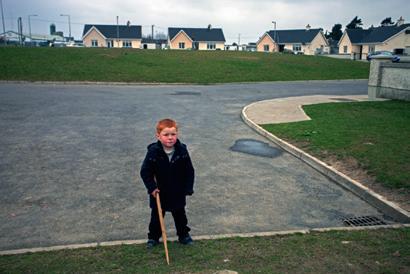




Though the idea for the book was born in Syria in 2012, when Murphy was “trekking silently for eight hours through regime-held villages under a blanket of darkness” with FSA rebels, it also owes its gestation to a single image that, as Murphy writes, “wouldn’t leave me alone”. That image is of a man seated backwards on a horse going over a tall hedge. It is, says Murphy, “a glimpse of the comedy we make of life, death and the rules in Ireland”. It could also serve as a metaphor for the management of the country during the financial carnage that followed of the collapse of the Celtic Tiger economy. Or a certain kind of paddywhackery that endures despite all that.
Murphy’s Ireland is both a strange and familiar place and it unfolds in a wilfully impressionistic fashion. An image of an elderly man having his hair sprayed at a barber’s in Ballymun, Dublin is emblematic of Murphy’s approach, being quietly humorous but also indicative of the changes that have come about of late in a society that, not that long ago, was masculine, conservative and, even in the capital, relatively parochial. A portrait of a group of students in evening dress at Trinity College Dublin is followed by a another of two women in saris cooking in their kitchen in Navan, Co Meath. There are several Irelands in this book and they coexist even if they are often relatively invisible to each other.
Here and there, Murphy sails close to the tropes of an older kind of photography about another Ireland: red-haired children, big skies, crowds at GAA matches and race meetings. But this Ireland endures too and, if anything, has grown stronger since the country’s late surge towards modernity. For me, his images work best when they steer clear of the overfamiliar for a more oblique and thus more suggestive approach: a trail of footprints in concrete rendered golden by streetlights or a group of young footballers huddled in a ring beneath the moonlight, the goalposts in the background stark against shadowy trees. Another Ireland is evoked, a still tentative place edging its way towards an uncertain future once again.
Sean O’Hagan, The Observer, April 19, 2016
ISBN 978-0-241-19709780241 197097 90000
SEAMUS MURPHY
Cover design: Lizzie Ballantyne THE REPUBLIC 8 THE REPUBLIC 22 23 THE REPUBLIC 32 33 THE REPUBLIC 39 ©
Seamus Murphy grew up in Ireland and lives in London. The author of four books, including A Darkness Visible: Afghanistan, he is the recipient of seven World Press Photo awards for his work in Afghanistan, Gaza, Lebanon, Sierra Leone, Peru and Ireland. He has been published in all major international publications and more recently made films for The New Yorker and Channel 4 News He has worked with musician PJ Harvey on film and photography projects including their most recent collaboration, The Hollow of the Hand
JUSTIN MCKIE
 A man displays his horsemanship by riding backwards over a steep hedge during an afternoon with the Killinick Harriers Hunt Club. From the book The Republic (Allen Lane, 2016), Seamus Murphy’s personal and immediate look at his homeland on the eve of the 100th anniversary of its revolutionary Easter Rising, which paved the way for independence for the south of the island, the Republic of Ireland. Grange, Killinick, County Wexford, Republic of Ireland, March 10, 2011.
A man displays his horsemanship by riding backwards over a steep hedge during an afternoon with the Killinick Harriers Hunt Club. From the book The Republic (Allen Lane, 2016), Seamus Murphy’s personal and immediate look at his homeland on the eve of the 100th anniversary of its revolutionary Easter Rising, which paved the way for independence for the south of the island, the Republic of Ireland. Grange, Killinick, County Wexford, Republic of Ireland, March 10, 2011.
STEFANO DE LUIGI KENYA DROUGHT
As a child, Stefano De Luigi (b. 1964, Germany) discovered photograph albums that recorded decades of unconventional family histories; his father’s family intertwined with the legacy of the Italian colonies in Africa. He found grainy prints from Libya, Eritrea, Somalia, and Ethiopia that sparked in him a lifelong fascination with the image and its ability to represent our inner voices. Multi-lingual Stefano regards pop culture — from television, fashion, pornography, cinema and political propaganda — and scrapes away the make-up and the polish to ask, is what you’re seeing actually what you think you see?

The remains of a giraffe, its long neck stiffened into an awkward curve, pose in an image of Kenya I’d never before imagined. A lifeless zebra, an unidentifiable carcass, and a young scrawny cow seeking refuge in a tiny strip of shadow reinforce that all is not well.

Stefano de Luigi’s series “Drought in Kenya,” evocatively captures a truth that’s more inclusive than we’ve ever seen of the devastation wreaked on Kenya as it experienced the worst food security crisis in Africa in 20 years. Famine and starvation we usually see illustrated in sheer numbers, pertaining purely to the people. But the reality extends to all life on these parched and fractured plains, which form a part of the wider circle.
Despite being considered one of Africa’s most developed nations, the 2008/9 droughts depicted in de Luigi’s images formed the tipping point, following years of consecutive setbacks. While once severe drought occurred as part of a 10-year cycle, an interval that was not only expected but also manageable, a change in global weather patterns brought three serious droughts within a decade.


Kenya emerged from its most previous encounter just two years earlier. Stretching from 2004 into 2006, five million people were affected. In the dramatically short period for recovery that followed, Kenya was instead preoccupied with floods in 2006 and post-election violence in 2007.
Amid back-to-back casualties, by the 2008/9 episode depicted, the figures had doubled as drought touched 10 million Kenyans, crippled even further by floods that ravaged parts of the country again just one year later.

These images of Kenya in the grips of drought delicately illustrate the fragile balance, yet also the similarities, between humans and animals as they together tread the thin line of survival.

With livestock forming the livelihood for many of Kenya’s population, traditional herders raise and sell livestock to get by, while many require animals to be capable of working the lands and carrying loads long distances. But just as the people get more and more desperate and weaker every day, so too do the animals on which they rely. Herders must decide whether to take the risk of exerting themselves and their livestock on long roams in search of water, or to stop and conserve energy on a regular basis.
While some plastic water tanks are trucked in by Kenya’s government, it’s often not enough for everyone, or for every day until the next truck arrives to be greeted by increasingly-desperate Kenyans anxiously awaiting. This water, too, may have to be shared with their livestock. While some areas still have water running from water taps, in others they have run completely dry. Dirty water pans that remain are commonly shared between animals and humans.
According to wildlife officials, scores of roaming wild animals, such as elephants, buffalo, and giraffes, are dying of thirst and starvation. They are also succumbing to diseases and infections due to weakened immune systems, much like the starving human population. Stories of infants and livestock being snatched by wild predators also aren’t uncommon as wild animals move closer to human-occupied lands in desperate search of water and food.
Adding to the pressure, conflicts are escalating between local tribes as food, water, and resources dissipate. Further battles arise at borders with neighboring countries, particularly Somalia, where refugees flock to the Kenyan border to flee their own severe drought and political turmoil. The spread of weapons under such desperate conditions incites further bloodshed and violence.
Paradoxically, it is only in death that the connection between sentient creatures becomes tangible, and the circle is disrupted.”
Tijana Jaksic, extract from The Australian PhotoJournalist No. 8, 2010

38 The Sunday Times Magazine SPECTRUM November 8, 2009 38 November 8, 2009 The Sunday Times Magazine SPECTRUM 39 39 DISASTER ZONE A four-year drought has pushed as many as 4m Kenyans to the brink of starvation; it’s the worst drought in more than decade. As many as one in ten people are surviving on emergency rations supplied by the World Food Programme. Four consecutive harvests have failed in the southeast, while the Rift Valley — traditionally Kenya’s breadbasket — has become a wasteland. Many farmers have been forced to abandon rural areas and move into already overpopulated urban slums. Kenya’s economy has suffered as a result of a dramatic fall in tea and coffee production, while tourists have found its once lush game reserves littered with animal carcasses. Kenya’s unstable coalition government, forced together last year after a violent election, has been accused of worsening the situation by failing to safeguard grain reserves. Instead, thousands of sacks of maize have gone missing — with many reappearing in neighbouring Sudan, high-level corruption is suspected. Although drought is common in East Africa, water shortages are now much more frequent. Many blame climate change. Although the rains finally started to arrive last month, they are too late for the parched landscape of the Rift Valley province which has begun to crumble, leading to landslides and ooding. Aid agencies have warned of the widespread risk of malaria and hypothermia. Cover: the body of young giraffe lies across the road in Wajir, northeast Kenya. Top left: villagers walk though the arid landscape in Nadapal in the Turkana district. Above: an elephant carcass decomposes in Samburu National Park. Left: a pump, which once provided vital water for the Turkana village of Kokuro, has now completely dried up. Bottom left: a boy in the village of Lochorembey, suffering from dehydration and malnutrition. Photographs: Stefano De Luigi spectrum - stm08038.indd 3-4 29/10/2009 19:51 DIGGING FOR SURVIVAL Members of the Turkana tribe desperately try to collect water for their families and livestock from a homemade bore-hole near a village, Kaitede, in Kenya’s Turkana district. Photograph by Stefano De Luigi spectrum m - stm08040.indd 5-6 29/10/2009 19:52 渇きと飢えのために死んだキリ ン。写真はすべてケニア。東北部 ワジール地方。2009年10月 ステファノ・デ・ルイジ Stefano De LUIGI VII Network DAYS JAPAN International Photojournalism Awards First Prize DAYS 国際フォトジャーナリズム 大賞 1位 DAYS JAPAN 2010/5 8 ケニアの干ばつ Drought in Kenya P8-13_ステファノ・�ルー�_高画質.indd 8-9 10.4.16 0:25:02 AM © RON HAVIV
 The corpse of a giraffe lies in the dry bed of a river in a desert area north of the town of Waijir in Northeast Kenya, near the border with Somalia, October 2009.
The corpse of a giraffe lies in the dry bed of a river in a desert area north of the town of Waijir in Northeast Kenya, near the border with Somalia, October 2009.
TOMAS VAN HOUTRYVE BLUE SKY DAYS
Tomas van Houtryve is an artist, photographer, and author who engages in critical issues around the world. His major works interweave contemporary concepts, investigative journalism and metaphor, occupying the intersection between art and pure documentary. Many of his projects push the technical limits of photography, from 19th-century chemical processes to thermal imaging and Augmented Reality; this meeting of the old and the new was encapsulated in his work after the great fire that devastated Notre Dame Cathedral in Paris, France in 2019, when he flew a drone-mounted camera through and above the tattered building to capture its devastation.
Henri Cartier-Bresson preferred photographing under grey or cloudy skies. The absence of shadows and direct sunlight allowed him to stalk his subjects and shoot them unawares from any angle. For equally obvious reasons, drone operators prefer clear skies. The grandson of a woman killed by a drone while picking okra outside her house in Pakistan told a group of lawmakers, “I no longer love blue skies. In fact, now prefer grey skies. The drones do not fly when the skies are grey.”
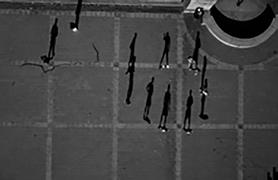


For the photographs in his Blue Sky Days series, Tomas van Houtryve attached a camera to a small drone and flew it, through blue American skies, over the kind of gatherings that might engage the attention of drone operators in other parts of the world. A number of related photographic elements converge on the project. First, the giddy bird’s-eye views of early modernists such as Aleksandr Rodchenko and — less spectacularly — André Kertész, who were drawn to the combination of abstracted geometries and vertiginous human gestures. Second, the technology of remote or




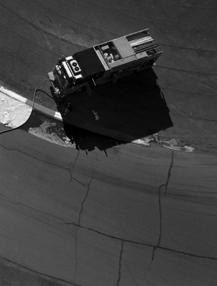




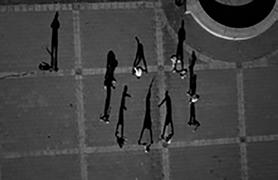










automated surveillance — the opposite of the kind of highly individualized stalking of which Cartier-Bresson was the master. Put these two together — and they have very often been put together — and you get numerous opportunities for spying, sneaking and peeping. But in the background - or at a higher altitude, as it were — there is the long-standing use of the camera for purely military uses: for aerial reconnaissance, to study potential bombing targets and assess the effectiveness of such operations.
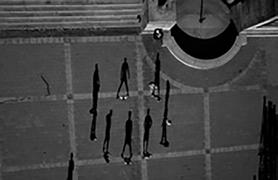
So there’s a lot of history at work here, especially if we go along with T.S. Eliot’s famous gloss on a line of Emerson’s: that history is the lengthened shadow of a man. People appear as counters on the patterned squares of an urban board: pawns in a geopolitical game. Lest we get overly anxious, however, there’s nothing really sinister going on. This, after all, is a photographer’s entirely non-lethal project. We have nothing to fear. The design is aesthetic (albeit ideologically loaded) rather than strategic, and the results are summer-sky beautiful. Especially
when seen vertically on a wall — or a computer screen — rather than horizontally on a page, from above. Viewed like this, the shadows take on a life of their own, acquire again the human qualities lost to the barely visible “counters.” The problem is that these shadow gestures are difficult to read or interpret with any accuracy. Playing looks like fighting. Clowning around becomes aggressive — and mistakes have consequences. Being shot by a camera becomes a prelude to being shot for real.




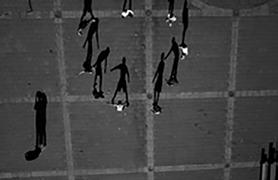

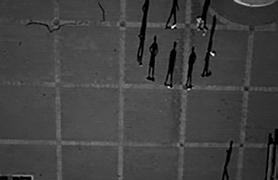


The more you look at these jet-black shapes, the deeper the temporal perspective becomes. The stretched silhouettes acquire not just the primal quality of Giacometti’s etiolated sculptures. They start to loom like figures painted on a cave wall: humans vulnerable to the threat of beasts and forces they hope to keep at bay. In the caves, that threat is always abundantly depicted. Here it is nowhere to be seen. It is the seeing.

© MARCO CASINO
Geoff Dyer, excerpt from See/Saw: Looking at Photographs 20102020 (Graywolf Press 2021)
 People exercising in central Philadelphia. As an unnamed senior U.S. government official said to The New York Times in May 2012, “three guys doing jumping jacks” might for the CIA constitute sufficient evidence of a terrorist training camp — an allusion to policies whereby unidentified persons overseas who exhibit so-called signature behaviors are targeted in “signature strikes.” Philadelphia, USA, 2013.
People exercising in central Philadelphia. As an unnamed senior U.S. government official said to The New York Times in May 2012, “three guys doing jumping jacks” might for the CIA constitute sufficient evidence of a terrorist training camp — an allusion to policies whereby unidentified persons overseas who exhibit so-called signature behaviors are targeted in “signature strikes.” Philadelphia, USA, 2013.
 Personal belongings exhumed from mass graves alongside the mortal remains of Bosnians who perished in the genocide in Srebrenica area in 1995. These artifacts are used in forensic analysis to identify the victims and are used as evidence in ongoing criminal prosecutions of war crimes. Tuzla, Bosnia and Herzegovina, 2010.
VII Academy Webpage theviifoundation.org/vii-academy
See Through the Noise: Exhibition App app.vii.academy
Personal belongings exhumed from mass graves alongside the mortal remains of Bosnians who perished in the genocide in Srebrenica area in 1995. These artifacts are used in forensic analysis to identify the victims and are used as evidence in ongoing criminal prosecutions of war crimes. Tuzla, Bosnia and Herzegovina, 2010.
VII Academy Webpage theviifoundation.org/vii-academy
See Through the Noise: Exhibition App app.vii.academy










 Preparations for the funeral of an 8-year-old child who died of cold in Herat Marsak refugee camp. His two uncles prepare the body before bringing him to the camp cemetery under the eyes of a few of his family members. 30,000 internally displaced people live in miserable conditions in a camp a few kilometers away from Herat, Western Afghanistan. Because of the draught and the war raging on several fronts in Afghanistan, one million people face a humanitarian disaster all over the country. Near Herat, Western Afghanistan, February 15, 2001.
Preparations for the funeral of an 8-year-old child who died of cold in Herat Marsak refugee camp. His two uncles prepare the body before bringing him to the camp cemetery under the eyes of a few of his family members. 30,000 internally displaced people live in miserable conditions in a camp a few kilometers away from Herat, Western Afghanistan. Because of the draught and the war raging on several fronts in Afghanistan, one million people face a humanitarian disaster all over the country. Near Herat, Western Afghanistan, February 15, 2001.




































 Mahdi Mahmud is hung by rope from the roof of the hallway by the Iraqi Reconnaissance Unit as part of his torture and interrogation. Mahdi Mahmoud was displaced from Mosul with his family to his village. He and his 16-year-old son Ahmad were arrested upon arrival. They were tortured for more than an hour and later released. Two weeks later, Ali Arkady was told that the Intelligence Regiment arrested Ahmad Mahdi and executed him with a group of detainees near Qabr al-Abd village, Hammam al-Alil, South Mosul. Iraq, November 23, 2016.
Mahdi Mahmud is hung by rope from the roof of the hallway by the Iraqi Reconnaissance Unit as part of his torture and interrogation. Mahdi Mahmoud was displaced from Mosul with his family to his village. He and his 16-year-old son Ahmad were arrested upon arrival. They were tortured for more than an hour and later released. Two weeks later, Ali Arkady was told that the Intelligence Regiment arrested Ahmad Mahdi and executed him with a group of detainees near Qabr al-Abd village, Hammam al-Alil, South Mosul. Iraq, November 23, 2016.




 The ruined auditorium of the House of Culture in Shushi. It was shelled in the first days of October 2020, during the 44-Day War in Nagorno-Karabakh. Shushi, Nagorno-Karabakh, October 16, 2020.
The ruined auditorium of the House of Culture in Shushi. It was shelled in the first days of October 2020, during the 44-Day War in Nagorno-Karabakh. Shushi, Nagorno-Karabakh, October 16, 2020.













































 © CHRISTOPHER MORRIS
© CHRISTOPHER MORRIS
 A Chechen fighter escapes out the front door of the Presidential Palace. He has a long and exposed run out in the open until he can reach cover. Grozny, Chechnya, January 1995.
A Chechen fighter escapes out the front door of the Presidential Palace. He has a long and exposed run out in the open until he can reach cover. Grozny, Chechnya, January 1995.







 Daniel Schwartz, May 2023
© PHILIP BLENKINSOP
Daniel Schwartz, May 2023
© PHILIP BLENKINSOP
 Coal worker, Yungang Yun loading station, Datong. Shanxi province, China, 20 November 1987.
Coal worker, Yungang Yun loading station, Datong. Shanxi province, China, 20 November 1987.


 John Neumann works on an old pickup truck at Neumann Ranch, a place his girlfriend Julie Long calls a broken-down horse and cattle ranch. John took his life on June 9, 2019, in part due to the lack of medical care in his remote region on the Great Plains of the United States. Rural America is seeing a dramatic rise in suicides. Studies show that the rate of suicide in rural counties is 25 percent higher than major metropolitan areas. Cactus Flat, South Dakota, 2008.
John Neumann works on an old pickup truck at Neumann Ranch, a place his girlfriend Julie Long calls a broken-down horse and cattle ranch. John took his life on June 9, 2019, in part due to the lack of medical care in his remote region on the Great Plains of the United States. Rural America is seeing a dramatic rise in suicides. Studies show that the rate of suicide in rural counties is 25 percent higher than major metropolitan areas. Cactus Flat, South Dakota, 2008.


 Maxine Peters, 90, passes away at home surrounded by her family, friends, and hospice aides, after a long battle with Parkinson’s Disease and dementia. In many parts of rural America people still live and die, the old-fashioned way. The Hospice Care Corporation, based in West Virginia, sends health workers into rural homes to make sure that people can meet a dignified end, surrounded by their families and loved ones. Gladesville, West Virginia, October 9, 2000.
Maxine Peters, 90, passes away at home surrounded by her family, friends, and hospice aides, after a long battle with Parkinson’s Disease and dementia. In many parts of rural America people still live and die, the old-fashioned way. The Hospice Care Corporation, based in West Virginia, sends health workers into rural homes to make sure that people can meet a dignified end, surrounded by their families and loved ones. Gladesville, West Virginia, October 9, 2000.















 The new cemetery outside of the city in the middle of the woods. Irpin, Ukraine, April 25, 2022.
The new cemetery outside of the city in the middle of the woods. Irpin, Ukraine, April 25, 2022.




















 Over 3,000 people gather for Friday prayers at the ruins of the main mosque, one of the towns worst hit by the Kashmir earthquake. Three months after the October 2005 earthquake that devastated parts of Kashmir, hundreds of thousands of people were still homeless, many living in tents and collapsed buildings, facing icy winter conditions in the mountains. Balakot, Kashmir, January 27, 2006.
Over 3,000 people gather for Friday prayers at the ruins of the main mosque, one of the towns worst hit by the Kashmir earthquake. Three months after the October 2005 earthquake that devastated parts of Kashmir, hundreds of thousands of people were still homeless, many living in tents and collapsed buildings, facing icy winter conditions in the mountains. Balakot, Kashmir, January 27, 2006.





















 In the past, residents hung curtains to protect the family’s privacy, to protect the home from wind and sand storms, and to protect from the heat. Now the curtains protect them from Bashar Assad’s snipers, and are visible in all the frontlines in the city. Salah Aldin neighborhood front line, Aleppo, Syria, February 10, 2013.
In the past, residents hung curtains to protect the family’s privacy, to protect the home from wind and sand storms, and to protect from the heat. Now the curtains protect them from Bashar Assad’s snipers, and are visible in all the frontlines in the city. Salah Aldin neighborhood front line, Aleppo, Syria, February 10, 2013.



 Lance Corporal Andrew Julian Aviles from the 3rd Battalion 4th Marines lies behind his destroyed Amtrak a few meters from Dyala Bridge. Our position had been subject to an intense artillery barrage, and a shell had entered the Amtrak through the top hatch. It killed Aviles and Corporal Jesus Medellin. Others were injured. Dyala Bridge, near Baghdad, Iraq, April 7, 2003.
Lance Corporal Andrew Julian Aviles from the 3rd Battalion 4th Marines lies behind his destroyed Amtrak a few meters from Dyala Bridge. Our position had been subject to an intense artillery barrage, and a shell had entered the Amtrak through the top hatch. It killed Aviles and Corporal Jesus Medellin. Others were injured. Dyala Bridge, near Baghdad, Iraq, April 7, 2003.










































 African migrants crowd the night shore of Djibouti City, trying to capture service from inexpensive cellular networks — a tenuous link to relatives abroad — from neighboring Somalia. For more than 60,000 years our species has been relying on such intimate social connections to spread across the Earth. Djibouti City, Djibouti, February 26, 2013.
African migrants crowd the night shore of Djibouti City, trying to capture service from inexpensive cellular networks — a tenuous link to relatives abroad — from neighboring Somalia. For more than 60,000 years our species has been relying on such intimate social connections to spread across the Earth. Djibouti City, Djibouti, February 26, 2013.





























































 Albanian school children look out of a window reflecting the Serbian side of Mitrovica, a divided city in the north of Kosovo and one of the remaining parts of Kosovo that still has Serbians living there. Mitrovica, Kosovo, 2000.
Albanian school children look out of a window reflecting the Serbian side of Mitrovica, a divided city in the north of Kosovo and one of the remaining parts of Kosovo that still has Serbians living there. Mitrovica, Kosovo, 2000.








































 The trademark knuckle-duster; Dave Courtney discusses his life of crime at the Oxford Union. Oxford, United Kingdom, October 1999.
The trademark knuckle-duster; Dave Courtney discusses his life of crime at the Oxford Union. Oxford, United Kingdom, October 1999.










 © JAN CHRISTENSEN
© JAN CHRISTENSEN
 The view from the artist’s family’s window in Algiers is juxtaposed with an old photograph of her grandmother, Aisha. It accompanies a personal letter written by her grandmother to her granddaughter a few months before her passing. Algiers, Algeria, 2005.
The view from the artist’s family’s window in Algiers is juxtaposed with an old photograph of her grandmother, Aisha. It accompanies a personal letter written by her grandmother to her granddaughter a few months before her passing. Algiers, Algeria, 2005.



































































































 Refugees from Syria rest on the coast of the Greek island of Lesbos. Thousands of refugees cross the Aegean Sea from Turkey in rubber boats every day, fleeing conflict in Syria, Iraq, and Afghanistan. Lesbos, Greece, September 24, 2015.
Refugees from Syria rest on the coast of the Greek island of Lesbos. Thousands of refugees cross the Aegean Sea from Turkey in rubber boats every day, fleeing conflict in Syria, Iraq, and Afghanistan. Lesbos, Greece, September 24, 2015.































































 After washing clothes in a roadside puddle, a woman walks home through a parched field in drought-stricken Somaliland. A changing, more extreme climate has upended millions of lives in the Horn of Africa. As cattle, goats, and camels have died off, seminomadic pastoralists like her have had no choice but to move, often to displacement camps or cities. Somaliland, April 6, 2016.
After washing clothes in a roadside puddle, a woman walks home through a parched field in drought-stricken Somaliland. A changing, more extreme climate has upended millions of lives in the Horn of Africa. As cattle, goats, and camels have died off, seminomadic pastoralists like her have had no choice but to move, often to displacement camps or cities. Somaliland, April 6, 2016.









 Somali aid workers take it in turn to dig graves at one of the cemeteries. At the time several hundred people died here every day. Because of looting by heavily armed gangs, the distribution of aid approved by the U.N. in July could not be adequately policed. This situation did not significantly improve until Operation Restore Hope got underway at the end of 1992. Baidoa, Somalia, August 1, 1992.
Somali aid workers take it in turn to dig graves at one of the cemeteries. At the time several hundred people died here every day. Because of looting by heavily armed gangs, the distribution of aid approved by the U.N. in July could not be adequately policed. This situation did not significantly improve until Operation Restore Hope got underway at the end of 1992. Baidoa, Somalia, August 1, 1992.















 © PHILIP BLENKINSOP
© PHILIP BLENKINSOP
 Believing that we are Americans returning to lead them all to safety, Hmong veterans of the CIA’s Secret War in Laos and their families fall to their knees crying as my colleague and I approach their secret camp. The group of some 840 people is one of several that has been targeted by Lao Government troops continuously since the end of the Vietnam War. Pha Sie Cliffs, Xaysomboune Military Zone, Laos, January 2003.
Believing that we are Americans returning to lead them all to safety, Hmong veterans of the CIA’s Secret War in Laos and their families fall to their knees crying as my colleague and I approach their secret camp. The group of some 840 people is one of several that has been targeted by Lao Government troops continuously since the end of the Vietnam War. Pha Sie Cliffs, Xaysomboune Military Zone, Laos, January 2003.









 Members of Arkan’s Serbian paramilitary group, the Tigers, with executed unarmed Muslim civilians Abduraham (L), Hamijeta Pajaziti (R), and Ajša (Tifa) Šabanović (C) during the first battle of the Bosnian war. Bijeljina, Bosnia, April 2, 1992.
Members of Arkan’s Serbian paramilitary group, the Tigers, with executed unarmed Muslim civilians Abduraham (L), Hamijeta Pajaziti (R), and Ajša (Tifa) Šabanović (C) during the first battle of the Bosnian war. Bijeljina, Bosnia, April 2, 1992.




 A Muslim widow gets ready to throw red carnations into the Drina River, marking the spot where some 2,000 Muslim men and boys were executed during the “ethnic cleansing” campaign waged by Serbs against their neighbors in the early months of the 1992-95 war. The bridge, built during the Ottoman Empire, was made famous by the Nobel-Prizewinning author Ivo Andric in his book, Bridge on the River Drina Visegrad, Bosnia and Herzegovina, May 25, 2003.
A Muslim widow gets ready to throw red carnations into the Drina River, marking the spot where some 2,000 Muslim men and boys were executed during the “ethnic cleansing” campaign waged by Serbs against their neighbors in the early months of the 1992-95 war. The bridge, built during the Ottoman Empire, was made famous by the Nobel-Prizewinning author Ivo Andric in his book, Bridge on the River Drina Visegrad, Bosnia and Herzegovina, May 25, 2003.







 A man displays his horsemanship by riding backwards over a steep hedge during an afternoon with the Killinick Harriers Hunt Club. From the book The Republic (Allen Lane, 2016), Seamus Murphy’s personal and immediate look at his homeland on the eve of the 100th anniversary of its revolutionary Easter Rising, which paved the way for independence for the south of the island, the Republic of Ireland. Grange, Killinick, County Wexford, Republic of Ireland, March 10, 2011.
A man displays his horsemanship by riding backwards over a steep hedge during an afternoon with the Killinick Harriers Hunt Club. From the book The Republic (Allen Lane, 2016), Seamus Murphy’s personal and immediate look at his homeland on the eve of the 100th anniversary of its revolutionary Easter Rising, which paved the way for independence for the south of the island, the Republic of Ireland. Grange, Killinick, County Wexford, Republic of Ireland, March 10, 2011.







 The corpse of a giraffe lies in the dry bed of a river in a desert area north of the town of Waijir in Northeast Kenya, near the border with Somalia, October 2009.
The corpse of a giraffe lies in the dry bed of a river in a desert area north of the town of Waijir in Northeast Kenya, near the border with Somalia, October 2009.


































 People exercising in central Philadelphia. As an unnamed senior U.S. government official said to The New York Times in May 2012, “three guys doing jumping jacks” might for the CIA constitute sufficient evidence of a terrorist training camp — an allusion to policies whereby unidentified persons overseas who exhibit so-called signature behaviors are targeted in “signature strikes.” Philadelphia, USA, 2013.
People exercising in central Philadelphia. As an unnamed senior U.S. government official said to The New York Times in May 2012, “three guys doing jumping jacks” might for the CIA constitute sufficient evidence of a terrorist training camp — an allusion to policies whereby unidentified persons overseas who exhibit so-called signature behaviors are targeted in “signature strikes.” Philadelphia, USA, 2013.
 Personal belongings exhumed from mass graves alongside the mortal remains of Bosnians who perished in the genocide in Srebrenica area in 1995. These artifacts are used in forensic analysis to identify the victims and are used as evidence in ongoing criminal prosecutions of war crimes. Tuzla, Bosnia and Herzegovina, 2010.
VII Academy Webpage theviifoundation.org/vii-academy
See Through the Noise: Exhibition App app.vii.academy
Personal belongings exhumed from mass graves alongside the mortal remains of Bosnians who perished in the genocide in Srebrenica area in 1995. These artifacts are used in forensic analysis to identify the victims and are used as evidence in ongoing criminal prosecutions of war crimes. Tuzla, Bosnia and Herzegovina, 2010.
VII Academy Webpage theviifoundation.org/vii-academy
See Through the Noise: Exhibition App app.vii.academy